

Beirut to Baalbek: how to visit Baalbek in Lebanon
This post is a travel guide about how to visit Baalbek in Lebanon and about my experience travelling from Beirut to Baalbek on a daytrip. Baalbek ios among the best places to visit in Lebanon , especially if you love history.
Up untill the last moment I hesitated whether I should travel from Beirut to Baalbek, because of its proximity to Syria. It was 2015 and I just saw in the news that in Anjar, only 20 kilometers north from Baalbek, the Lebanese army was fighting IS.

Why visit Baalbek Lebanon?
Obviously I was in doubt and maybe crazy for even considering to travel from Beirut to Baalbek in Lebanon at that time. But the Bekaa valley is also one of the most beautiful parts of the country and Baalbek is one of the best preserved Roman ruins in the Middle East, only to be compared with Jerash in Jordan .
Travelling from Beirut to Baalbek is relatively easy and it makes for a great day trip from Lebanon’s capital. I tried to call the Lebanese Tourism Information board, but got no response. Finally I decided to head to the bus station myself to see if I would be able to go.
Before I continue to share my experiences, let me tell you that I had a great daytrip from Beirut to Baalbek and that in the end there really wasn’t so much to worry about. Security concerns have only improved and it is absolutely safe to travel from Beirut to Baalbek in Lebanon.

Getting from Beirut to Baalbek
I arrived at the Cola intersection in the early morning and the bus drivers found me before I could find the bus from Beirut to Baalbek. There were still frequent buses going. I knew that was a good sign.
When I asked whether it was safe to visit Baalbek, our driver didn’t seem too concerned “Sure, why not? people go there every day”. It wasn’t clear who these people were. Certainly no tourists as I was the only one around, but I was happy with the answer.
Baalbek wasn’t so popular after all and it took a long time for the van to fill up. I was almost about to give up on my plan to visit Baalbek when at the last moment a big family showed up taking the last vacant seats. The driver started the engine, everyone got on board and off we went.

Lebanon’s Bekaa valley
I was finally on my way from Beirut to Baalbek. It took a while before we could leave the congested traffic of the city behind us. But as soon as we entered the Bekaa valley, I could see why this is considered to be one of the most beautiful parts of Lebanon.
Small villages surrounded by vineyards and orchards with snow-capped mountains in the back. It is hard to believe that this seemingly peaceful place had some pretty violent times in the past.
Now everything was quiet. Although we passed several Syrian refugee tent camps that are a strong reminder of the political turmoil across the border. The fertile soil is apparently also good for growing hashish and opium poppies and the Bekaa valley has a long history of illicit drug trade.
As much as I loved to explore more of the Bekaa valley the main purpose of my day was to visit the Roman ruins in Baalbek. The journey from Beirut to Baalbek took about three hours. As I enjoyed the scenery so much I was almost sad to arrive.

Roman ruins in Baalbek
Because it was friday most shops in the town of Baalbek were closed and it was eerily quiet. I quickly made my way to the Roman ruins. A single man trying to sell his Hezbollah souvenirs approached me immediately. He had not seen any other tourists for the whole week and was hoping this was his lucky day.
The Roman ruins in Baalbek were well worth the visit and much better than any of the ruins left in Rome itself. Where else can you wander around alone through a Roman temple complex so well-preserved that it is like travelling back in time. It reminded me of Jerash in Jordan, but then without the tourist crowds.
The Greek and Romans called it the city of the sun (Heliopolis). The acropolis has several temples of which the iconic temple of Bacchus is one of the best preserved. However, the other temples such as the temple of Jupiter and the temple of Venus are also quite impressive.

Back to Beirut
Without hordes of tourists it was also a peaceful spot. After wandering around the Roman ruins in Baalbek for several hours through temples and old stones it was time to head back.
I quickly found a bus back to Beirut. This time the van filled up pretty quickly and it seemed our driver was in a hurry. He was driving on full speed on a back road through the mountains. He made it to Beirut in almost two hours, but this was probably the most dangerous experience of the day.

Beirut to Baalbek: a day trip guide
How to get from beirut to baalbek.
It is very easy to travel from Beirut to Baalbek by public transport. Mini vans leave when full from the Cola intersection or the Al Sayad roundabout in eastern Hamzieh in Beirut.
It can take some time for the vans to fill up, but it seems there is at least one leaving every hour from the Cola intersection. The journey itself from Beirut to Baalbek takes between 2 to 3 hours, depending on the traffic in Beirut.
Some vans will dropp you off in Baalbek center near the ruins. Other will dropp you off at the bus station that is 5 kilometers away from the Roman ruins in Baalbek. In this case you need to take an inexpensive taxi
To get back from Baalbek to Beirut you can head to the bus station or ask people where the minivans to Beirut depart from. Apparently there are several departure points. I was lucky that there was a mini van around the corner from the ruins that was about to leave.

The costs of a Beirut to Baalbek daytrip
Nowadays you can book organized tours from Beirut to Baalbek. If it’s your first time in Lebanon and travelling with public transport seems a bit too much for you, this might be something to consider. Expect to pay between 90 and 100 USD for a day tour.
If you go on your own by public transport, expect to pay between 10 – 15 USD for a roundtrip by minivan. The entrance fee to the Baalbek ruins is 15,000 LBP (around 10 USD).
When to visit Baalbek Lebanon?
Weather wise it’s best to avoid the summer heat. Spring and autumn are the best times to go and in winter it can even be a bit chilly.
The Baalbek temple is open from Munday to Sundays from 9 AM till 6 pm in summer and 4 pm in winter. In theory you could visit every day of the week.
However, keep in mind that on fridays most other places in Baalbek are closed. I did visit on a friday and it almost felt deserted. A pity as I heard that there are quite some good restaurants. If you like to experience Baalbeks lively market and delicious street food don’t come on a friday.

Other things to do in Baalbek
The Baalbek ruins are the biggest attraction in Baalbek, but there are some other things to do in Baalbek as well.
As you enter Baalbek town you will see a large golden domed mosque. This is actually not a mosque, but a Shia shrine dedicated to Sayyida Khawla, daughter of Imam Hussein and great-granddaughter of Prophet Muhammad.
South of the Sayyida Khawla shrine, 20 meters away from the main road you can find the somewhat mysterious stone of the pregnant woman. It’s one of the largest monoliths in the world and nobody knows how it was carved out
Baalbek also has some culinary delights waiting for you and it’s definetly worth it to make sure you have some time to visit Baalbeks lively bazaar.

Where to eat in Baalbek
I had lunch at Tavern Cezar. It was the only restaurant that was open when I was there on a friday and it was conveniently located opposite the entrance to the ruins. Prices were budget friendly and the portions generous. The food was ok and is a mix of Lebanese and international fast food.
A bit more up market is the Baalbeck palace serving traditional Lebanese food. One of the things you must try in Baalbek are Sfiha Baalbakieh. These Lebanese meat pies are a local speciality. They don’t serve them in a restaurant. You need to go to a butcher to order meat for Sfiha Baalbakieh and then go to a bakery that will bake them for you in the oven.
Because it was friday I missed out on trying the Sfiha Baalbakieh. One always needs a reason to return somewhere.

Where to sleep in Baalbek
It is easy to visit Baalbek on a day trip from Beirut, but if you prefer to spend the night in Baalbek there are several accomodation options. The best hotel is the historic and upmarket Palmyra hotel . It is in a renovated old home and has lots of charm, but probably not within the average backpackers budget. The Kanaan group hotel offers cheaper places to stay.
If you prefer to stay in Beirut there are more options. Budget travellers can stay in the Grand Meshmosh Hotel or the Hamra Urban Gardens . They are basic hotels woth dormitories in safe areas of Beirut. For a bit more luxury and private I can recommend the Beverly Hotel Beirut ot the Parisian hotel .
Is it safe to visit Baalbek?
Wen I was visiting Baalbek in Lebanon in 2015 it was a tense period with fights between the Lebanese army and IS going on near the border with Syria. As of 2022 things have become more calm and there should be no problem to visit the Roman ruins in Baalbek.
Even back in 2015 it was safe to visit Baalbek in Lebabon. Despite my worries about what I saw on the news, things were quiet in Baalbek and the parts of the Bekaa valley that I travelled through.
If I had one regret it was that I did not plan to spend more time in the Bekaa valley. It is clear that there is a lot of potential for tourism as you can see in this guide to the Bekaa valley by Jason Lemon. Besides the best Roman Ruins in Lebanon it also offers some of the best sceneries, mountain views and food.
Also check my post on Backpacking Lebanon to see all the other beautiful places that Lebanon has to offer.
Update : as of 2023 the security situation in Lebanon has unfortunately detoriated due to rampant inflation, increasing poverty and crime. The country is in a deep financial and economic crisis with water and electricity issues as a result. There was even a cholera outbreak in october 2022.
Disclaimer: This post about how to visit Baalbek and the best way to travel from Beirut to Baalbek contains affiliate links. If you buy any service through any of my links, I will get a small commission at no extra cost to you. These earnings help me to keep Backpack Adventures alive! Thanks for your support!

6 thoughts on “Beirut to Baalbek: how to visit Baalbek in Lebanon”
- Pingback: Top 8 things to do in Lebanon | Backpack Adventures
I was there in 2013 and it wasn’t as dangerous as it seems now – but the travel advisories still were no go for non essential travel.
Baalbek is just stunning – the scale of the Roman ruins is immense, the temple of Juniper is just so tall! We even managed to visit the nearby winery Ksara on the way back to Beirut – I’d love to visit this region again when the political situation is more stable.
Awesome review.. I’m looking to go in March, hopefully the situation changes or gets better.. any reviews on Morocco??
Incredible that Heliopolis is more preserved than Rome, shame thar almost nobody talks about it, afterall the Carthagian people wins, congratulations Lebanese.
Great itinerary! I’ve always wanted to visit Lebanon! And I love ancient ruins. Hopefully, I’ll have a chance to do this in 2021.
Baalbek is Solar !As Heliopolis it was named for the Egyptian city of the Sun, from where priests set out to found this sacred site to the Sun. ( Cassius Dio ) Please note these temples were Greek then seized by Romans from the Seleucid Empire of Alexander.’s general. So often this attribution of Roman happens dishonouring the Greeks.
Leave a Reply Cancel reply
Your email address will not be published. Required fields are marked *
- Kale by LyraThemes.com.
How To Visit The Baalbek Temple Ruins In Lebanon
One of the highlights of my visit to the Middle East would have to be Baalbek Lebanon, with its Roman ruins and giant megalithic stones.
This temple dates back to ancient times, and it can be visited pretty easily on a day trip from the Beirut area.
These amazing ruins are still in great condition considering their age, so they’re a must see if you happen to be passing through Lebanon or the Middle East.
Best Baalbek Lebanon Tours
First of all, if this is your first time in Lebanon, I would highly recommend visiting Baalbek with a tour package and guide.
GetYourGuide has prearranged day tours to Baalbek from Beirut, including free hotel pickup and drop-off, and a tour guide for the archaeological sites. This is easier and safer than trying to get there by yourself, and you’ll also have a better experience with a guide explaining everything for you.
We’ve used GetYourGuide for lots of tours and activities around the world, and they’re great. Highly recommended!
Book Now: Baalbek Private Tour
History Of Baalbek
The Baalbek valley (also spelled ‘Baalbeck’) has been settled since at least 9,000 BC, and in Bible times it was the site of gory human sacrifices to Baal, the Canaanite god of fertility. Some of the remnants of this ancient civilization can still be seen here.
Baalbek was renamed ‘Heliopolis’ after being conquered by the Greeks, and then it was later used by the Romans as a foundation for a new temple complex that took 250 years to build.
The most notable Roman buildings in the complex were the temples of Bacchus, Jupiter, and Venus. Together, these made up one of the largest temples of the entire Roman Empire.

Visiting The Baalbek Ruins
There are a lot of neat things to see in the Baalbek temple complex.
We spent at least a couple hours exploring everything (until a storm started to roll in), but if you’re a big fan of history and architecture then I’m sure you could stay even longer!
In my opinion, the best thing to see at Baalbek today is the Temple of Bacchus. This Roman temple is incredibly well preserved and still looks grand today, with its huge 20 meter (65 foot) columns still standing tall, and many of its sculptures and reliefs still intact.
If you only have a limited amount of time at Baalbek, definitely head over here first!
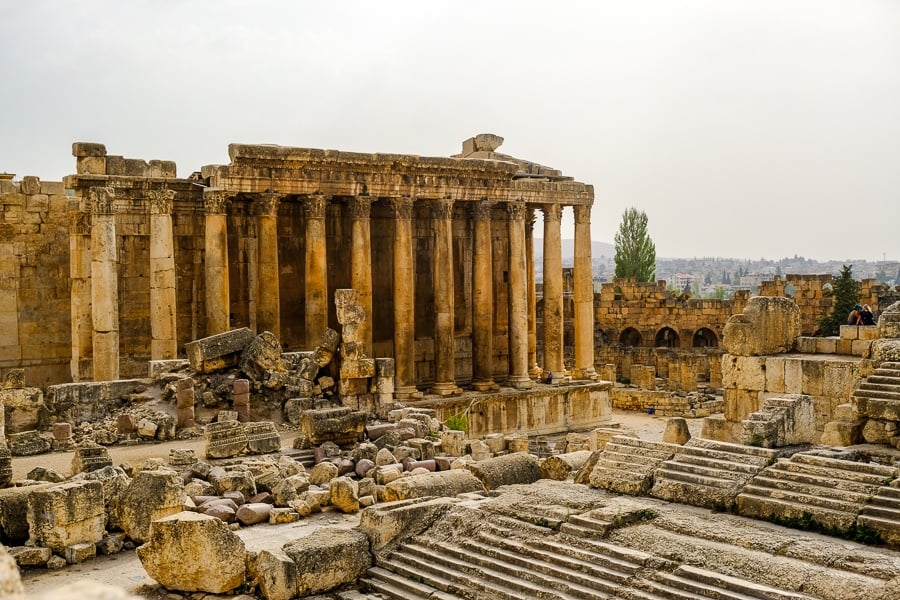
How To Get To Baalbek Lebanon
Baalbek is located about 90 kilometers (55 miles) northeast of the Beirut area.
You can do this drive in a rental car, but I wouldn’t recommend it unless you’re familiar with driving in the Middle East.
Traffic in Arab countries can be a bit dangerous and chaotic, so you’ll be much better off going with a driver who’s familiar with how the traffic works here.
The best idea is to book a prearranged day tour to Baalbek with an established company (more on that below).

More Lebanon Travel Tips
Thanks for looking! I hope you enjoyed this travel guide for Baalbek Lebanon (also spelled ‘Baalbeck’). The temple, ruins, and giant stones here are just fascinating.
Don’t forget to check out my complete Lebanon Travel Guide for more information before you go!
You may also like
13 best traditional shrines & temples to visit in japan, 7 days in bhutan travel itinerary: best things to do & see, tiger’s nest monastery hike in bhutan (paro taktsang), angkor wat travel guide for cambodia, 10-day bali itinerary & nusa penida highlights, how to visit himeji castle in japan.
So tempting! Also, there are claims that the Indians came in 4300 BC and built the original buildings.

Interesting!
Leave a Comment Cancel Reply
Save my name, email, and website in this browser for the next time I comment.
Our head office
0800 088 6002, [email protected], client log in, reset password, agent log in.

The ultimate guide to the Baalbek Temple Ruins in Lebanon: Monolithic Roman ruins conquered by Alexander the Great
Nestled within the heart of Lebanon lies a historical marvel that has withstood the test of time and witnessed the rise and fall of empires. The Baalbek Temple Ruins, an awe-inspiring testament to ancient engineering and imperial conquest, beckon modern-day adventurers and history enthusiasts to embark on a journey through time.
Standing as an indomitable symbol of Roman grandeur, these monolithic wonders have not only captured the imagination of archaeologists and scholars but have also enticed countless curious souls to delve into their enigmatic past. Among the echoes of the past, the resounding footsteps of none other than Alexander the Great himself can be heard, adding a layer of mystique to these already captivating ruins.
In this comprehensive guide, we invite you to accompany us on an exploration of the Baalbek Temple Ruins, as we uncover the stories etched into these ancient stones and the remarkable legacy they continue to impart.
The history of Baalbek - Roman Temple ruins in Lebanon
The history of the Baalbek Roman Temple ruins in Lebanon is a captivating journey through the annals of time, where architectural marvels, imperial dominion, and cultural significance intertwine to create a rich tapestry of historical heritage.
Baalbek's origins can be traced back to the Phoenician era, around 900 BCE, when it was known as Heliopolis, dedicated to the worship of the god Baal. During this period, the Phoenicians constructed sanctuaries on the site, laying the foundation for the religious and architectural legacy that would evolve over the centuries.
Under the sway of Alexander the Great's conquest in 334 BCE, Baalbek fell under Hellenistic influence. Renamed "Heliopolis" by the Greeks, the city began to incorporate elements of Greek architecture into its existing structures. This marked the first chapter of the site's transformation, as Greek aesthetics merged with Phoenician heritage.
However, it was during the Roman era that Baalbek's grandeur truly flourished. In 64 BCE, the Romans absorbed the city into their vast empire, and Baalbek flourished as a center of worship and commerce. It was during this time that the most iconic structures, known as the Roman Temple ruins, were constructed. These included the awe-inspiring Temple of Jupiter, the exquisite Temple of Bacchus, and the graceful Temple of Venus.
The Temple of Jupiter, dedicated to the chief Roman god, stood as a colossal testament to Roman engineering prowess. Gigantic stone blocks formed the foundation, and its sheer size left visitors in awe. The Temple of Bacchus, dedicated to the god of wine, boasted intricate carvings, elaborate Corinthian columns, and a level of detailing that showcased the pinnacle of ancient craftsmanship. The Temple of Venus, dedicated to the goddess of love, radiated elegance and reverence.
The decline of the Roman Empire in the 3rd century CE brought about a shift in Baalbek's fate. The city faced invasions, earthquakes, and changing power dynamics that led to a gradual deterioration of its once-thriving urban landscape. Successive rulers, including Arab, Byzantine, and Arab regimes, had varying influence on the ruins.
Despite the challenges, Baalbek's significance endured. European travelers during the 16th to 19th centuries marveled at the ruins and documented their splendor, igniting global interest in this ancient gem. Preservation efforts gained momentum in the 20th century to safeguard the ruins from further degradation, solidifying its status as a cultural treasure.
In 1984, the UNESCO World Heritage Site designation bestowed international recognition upon Baalbek's Roman Temple ruins, acknowledging their historical importance and architectural brilliance. Today, ongoing archaeological excavations and research continue to unveil new layers of Baalbek's history, ensuring that its legacy remains vibrant and enduring. The Baalbek Roman Temple ruins stand not only as a tribute to the past but also as a bridge that connects modern generations to the achievements and aspirations of ancient civilizations.
Was the city of Baalbek an ancient Phoenician city?
Yes, the city of Baalbek has ancient Phoenician origins. Originally known as "Heliopolis" in Phoenician times, it was a significant religious and cultural center dedicated to the worship of the god Baal. The Phoenicians, known for their maritime trade and cultural influence in the ancient Mediterranean region, established Baalbek as a place of reverence and importance.
With the arrival of Alexander the Great and subsequent Hellenistic rule, the city's name was Hellenized to "Heliopolis" and experienced a fusion of Greek architectural elements with its Phoenician heritage. Later, under Roman rule, Baalbek further developed into a major urban center with monumental temples and structures that showcased the grandeur of Roman engineering and architecture.
What does the name Baalbek mean?
The name "Baalbek" is derived from the Semitic languages of the ancient Near East, particularly Phoenician and Canaanite. It is a combination of two words: "Baal" and "Bek/Bekaa."
"Baal": This term refers to a deity, often associated with a god of fertility, weather, and agriculture in various ancient cultures. In the context of Baalbek, it likely refers to the worship of the god Baal, who was significant in Phoenician and Canaanite religious beliefs.
"Bek/Bekaa": This refers to the fertile Bekaa Valley, a region in Lebanon where the city of Baalbek is located. The Bekaa Valley has historically been an agriculturally productive area, making it a vital region for settlements and trade routes.
So, the name "Baalbek" essentially translates to something like "The City of Baal in the Bekaa Valley," reflecting the city's ancient religious and geographical significance.
When was the Baalbek temple built?
The construction of the temples at Baalbek, particularly the most famous ones like the Temple of Jupiter and the Temple of Bacchus, took place during the Roman period. The Temple of Jupiter, the largest and most significant of the temples in Baalbek, was built around the 1st century CE.
The Temple of Bacchus, dedicated to the Roman god of wine, was also constructed during the Roman period, likely in the early 2nd century CE. This temple is known for its remarkable preservation and intricate architectural details.
Overall, the Roman temples of Baalbek were built during the 1st and 2nd centuries CE, reflecting the architectural prowess and grandeur of the Roman Empire during that era.
Who built the ruins in Baalbek?
The Roman Temple ruins in Baalbek, particularly the monumental temples like the Temple of Jupiter and the Temple of Bacchus, were constructed during the Roman period. The actual individuals or architects responsible for their design and construction are not definitively known by name.
However, these structures were built under the patronage of the Roman emperors and with the resources of the Roman Empire. The Temple of Jupiter, for instance, was likely built during the reign of Emperor Augustus or his successors, while the Temple of Bacchus is attributed to the early 2nd century CE.
The construction of these temples required skilled architects, engineers, and laborers who were well-versed in Roman architectural techniques. The influence of various architectural styles, including Roman and Greek elements, is evident in the design and detailing of the structures.
While we may not have specific names associated with the builders, the enduring legacy of these ruins attests to the remarkable craftsmanship and engineering prowess of the ancient Roman civilization.
What are the Baalbek Stones? Was it a Roman Quarry?
The "Baalbek Stones" refer to the massive stone blocks used in the construction of the Roman temples and other structures at the Baalbek archaeological site in Lebanon. These stones are renowned for their size, weight, and the engineering marvel required to transport and assemble them.
The most famous example of the Baalbek Stones is the so-called "Trilithon," which consists of three enormous stone blocks located in the foundation of the Temple of Jupiter. Each of these blocks weighs approximately 800 tons, making them some of the largest quarried stones in the world. The exact methods by which these stones were quarried, transported, and lifted into position remain subjects of historical and archaeological inquiry.
Regarding your question about whether Baalbek was a Roman quarry, yes, it is believed that the site of Baalbek was utilized as a quarry during the Roman period. The stone blocks used in the construction of the temples and other structures were likely quarried in the immediate vicinity of Baalbek. The extracted stones would have been transported a short distance to the construction site, where they were carefully positioned to create the monumental edifices.
The precision and scale of the stone work at Baalbek are indeed indicative of the advanced engineering techniques of the Roman Empire. The site's quarries and the impressive stones they produced are a testament to the ingenuity and architectural achievements of the ancient Romans.
Who destroyed Baalbek Temple in Lebanon?
The Baalbek Temple complex in Lebanon was not destroyed by a single event or entity but rather experienced a combination of factors that led to its decline over the centuries. Unlike some other historical sites that were intentionally destroyed by conquerors, Baalbek's decline was a gradual process influenced by a variety of historical, natural, and cultural changes.
Here are some of the main factors that contributed to the decline of the Baalbek Temple complex:
Earthquakes: The region around Baalbek is prone to earthquakes, and throughout its history, the area has experienced seismic activity that caused damage to the temples and structures. Multiple earthquakes over the centuries may have weakened the buildings and contributed to their deterioration.
Changing Power Dynamics: As different empires and rulers came and went, the region's political landscape shifted. Baalbek came under the control of various powers, including Romans, Byzantines, Arabs, and others. These changes in control could have led to neglect or repurposing of the temples.
Gradual Abandonment: With the decline of the Roman Empire, the temples lost their religious significance and the city faced economic challenges. This could have led to a decline in maintenance and use of the structures.
Cultural and Religious Shifts: As religious beliefs changed over time, the temples may have lost their significance and relevance. New cultures and religious practices could have influenced the way the site was treated and utilized.
Weathering and Time: The passage of time and exposure to the elements can cause natural decay of structures. Weathering, erosion, and other environmental factors could have contributed to the deterioration of the temples.
It's important to note that while the Baalbek Temple complex experienced decline, it was not completely destroyed. Many of the structures still stand today, albeit in various states of preservation. The temples have also undergone restoration and conservation efforts in recent decades to preserve what remains of their historical and architectural significance.
Is Baalbek mentioned in the Bible?
Yes, Baalbek is mentioned in the Bible. It is often referred to as "Baal-Gad" in the Old Testament. Baal-Gad was a Canaanite city located in the region of modern-day Baalbek in Lebanon. In the Book of Joshua (Joshua 11:17, 12:7, 13:5), it is mentioned as one of the cities conquered by Joshua and the Israelites during their conquest of Canaan. Baal-Gad is also referenced in the Book of Judges (Judges 3:3) and in other biblical texts as a location in the land of Canaan. The name "Baal-Gad" is a combination of the Canaanite god "Baal" and "Gad," which is thought to refer to the tribe of Gad.
It's important to note that while Baalbek is associated with these biblical references, the massive Roman temple complex and ruins that it is primarily known for today were constructed centuries later, during the Roman period, and are not directly mentioned in the Bible.
How old is the Baalbek Temple?
The construction of the Temple of Jupiter is believed to have started around the 1st century AD during the Roman period, specifically during the reign of Emperor Augustus. However, the site itself has a longer history of religious significance, dating back to earlier cultures. The foundations of the temple complex might incorporate elements from even earlier structures, possibly from the Hellenistic period.
The Temple of Jupiter and the Baalbek complex as a whole showcase a blend of architectural styles and cultural influences over time. The complex's construction continued through the Roman period and into the reign of Emperor Antoninus Pius. The temple was dedicated to Jupiter, the Roman king of the gods.
The age of the Baalbek temple complex is around 2,000 years old, with its roots in earlier periods of history. It stands as a remarkable example of ancient Roman architecture and engineering, and it is one of the most impressive and well-preserved Roman ruins in the world.
Why should travelers visit the Baalbek Ruins in Lebanon?
Travelers should consider visiting the Baalbek Ruins in Lebanon for a variety of compelling reasons:
Historical Significance: The Baalbek Ruins are a testament to Lebanon's rich history and its role as a crossroads of civilizations. The site has been occupied by various cultures over thousands of years, including the Phoenicians, Greeks, Romans, and more.
Roman Architecture: The Baalbek Ruins feature some of the most impressive Roman architecture outside of Rome itself. The Temple of Jupiter, with its massive columns and intricate details, is a prime example of ancient Roman engineering and artistic craftsmanship.
Monolithic Wonders: One of the most intriguing features of the Baalbek Ruins is the presence of massive stone blocks known as "trilithons." These gigantic stones weigh hundreds of tons and remain a mystery as to how they were quarried, transported, and lifted into place with such precision.
Cultural Experience: Exploring the Baalbek Ruins provides travelers with a deep sense of connection to the past and an appreciation for the cultures that once thrived in the region. It's a unique opportunity to immerse oneself in history and gain insights into ancient religious practices.
Archaeological Insights: The ruins offer a glimpse into the past and the lives of the people who inhabited the area. Archaeological excavations have revealed artifacts and structures that shed light on the daily lives, customs, and beliefs of the ancient inhabitants.
Stunning Surroundings: The Baalbek Ruins are set against the backdrop of the beautiful Lebanese countryside, creating a picturesque and memorable setting for exploration and photography.
Educational Value: Visiting the ruins can be an educational experience for both individuals and families. Learning about the history, architecture, and cultural context of the site can be both enriching and enjoyable.
Adventure and Discovery: Exploring the Baalbek Ruins involves walking through ancient structures, climbing stairs, and navigating archaeological sites. This sense of adventure and discovery can make the visit even more exciting.
Cultural Heritage: By visiting the Baalbek Ruins, travelers contribute to the preservation of Lebanon's cultural heritage. Tourism can provide financial support for ongoing restoration efforts and the maintenance of the site.
Unique Travel Experience: Baalbek is not as widely visited as some other historical sites, which means that travelers can often enjoy a more intimate and less crowded experience as they explore the ruins.
What is the Temple of Jupiter?
The Temple of Jupiter is a monumental ancient Roman temple located within the Baalbek archaeological complex in Baalbek, Lebanon. It is one of the most significant structures within the complex and is considered one of the largest and most impressive Roman temples ever built. The temple was dedicated to Jupiter, the king of the Roman gods, and was an essential center of worship during the Roman period.
Key features and aspects of the Temple of Jupiter include:
Massive Size: The temple's sheer size is awe-inspiring. Its platform alone measures around 88 meters long and 48 meters wide. The temple itself stands on a raised platform and is surrounded by a peristyle (a colonnade of columns) on all sides.
Columns and Architecture: The temple's architecture is characterized by its massive columns, many of which are still standing today. The columns are Corinthian in style and are among the largest ever created in the Roman world. The temple's façade includes intricately carved details, showcasing the skill of ancient Roman craftsmen.
Trilithon: One of the most famous aspects of the Temple of Jupiter is the presence of enormous stone blocks known as the "trilithons." These are three massive stones placed on top of one another, forming a massive doorway or entryway. The weight and size of these stones have puzzled researchers for centuries, as they are among the largest monoliths ever quarried and transported in ancient times.
Cultural and Religious Significance: The Temple of Jupiter was a center of religious and cultural activity in the ancient Roman world. It played a crucial role in the worship of Jupiter, and the site was likely visited by pilgrims and worshippers from various regions.
Historical Layers: While the temple is primarily associated with the Roman period, the site itself has earlier layers of history. It is believed that the temple was built on the foundations of earlier structures, potentially dating back to the Hellenistic and even Phoenician periods.
Archaeological Significance: The temple complex, including the Temple of Jupiter, has been the subject of extensive archaeological studies and excavations. These studies have helped uncover details about the construction techniques, historical context, and cultural significance of the site.
The Temple of Jupiter at Baalbek is a remarkable example of ancient Roman architecture and engineering prowess. It stands as a testament to the grandeur and sophistication of the Roman Empire and remains a prominent historical and archaeological site that continues to captivate visitors with its size, craftsmanship, and mysteries.
What is the Temple of Venus (Temple of Bacchus)?
The Temple of Venus, also known as the Temple of Bacchus, is another significant ancient Roman temple located within the Baalbek archaeological complex in Baalbek, Lebanon. It stands adjacent to the larger Temple of Jupiter and is one of the most well-preserved and impressive Roman temples in the complex.
Key features and aspects of the Temple of Venus (Bacchus) include:
Dedication: The temple is often referred to as the Temple of Bacchus due to its association with the Roman god of wine, Bacchus. However, it is also dedicated to Venus, the Roman goddess of love and beauty. The dual dedication to both deities highlights the multifaceted nature of Roman religious practices.
Architecture: The Temple of Venus is renowned for its well-preserved architecture and intricate detailing. Like the Temple of Jupiter, it features Corinthian columns, ornate carvings, and other elements of classical Roman design.
Proportions: The Temple of Venus is often praised for its harmonious proportions and graceful design. It is slightly smaller in scale than the Temple of Jupiter but shares many architectural elements with it.
Peristyle and Interior: The temple is surrounded by a peristyle, which consists of a colonnade of columns encircling the temple. The interior of the temple features a sanctuary or cella where the cult statue of the deity was likely housed.
Integration with Landscape: The temple is situated on a platform and is carefully integrated into the natural landscape. Its location and design take advantage of the surrounding hills and offer stunning views of the surrounding area.
Artistic Detail: The Temple of Venus is known for its well-preserved decorative elements, including intricate friezes, reliefs, and carvings that depict scenes from Roman mythology, religious rituals, and daily life.
Historical Significance: Like the Temple of Jupiter, the Temple of Venus has been the subject of archaeological research and study. It provides insights into Roman religious practices, architectural techniques, and the cultural context of the time.
UNESCO World Heritage Site: The Temple of Venus, along with the entire Baalbek archaeological complex, was designated as a UNESCO World Heritage Site in 1984 due to its historical and cultural significance.
Visiting the Temple of Venus (Bacchus) offers travelers a chance to experience the grandeur and architectural brilliance of ancient Rome. Its proximity to the Temple of Jupiter and other structures in the complex makes Baalbek a treasure trove of ancient history and a captivating destination for those interested in exploring the marvels of Roman civilization.
Baalbek's Stone of the Pregnant Woman
The "Stone of the Pregnant Woman" is a massive stone block located in the ancient city of Baalbek, Lebanon. This stone block is one of the largest monoliths ever quarried by humans, and it remains partially cut from the quarry at the Baalbek archaeological site. The stone is estimated to weigh around 1,000 tons, making it one of the heaviest objects ever moved and worked by ancient civilizations.
The Stone of the Pregnant Woman is situated in the ancient quarry adjacent to the main archaeological complex of Baalbek. It lies on a hillside along with other partially quarried stones. The name "Stone of the Pregnant Woman" is believed to have originated from local legends and folklore rather than any historical evidence.
It's important to note that while the Stone of the Pregnant Woman is impressive in size, it is not part of the finished structures like the Temple of Jupiter or the Temple of Venus. Instead, it was left in the quarry as an unfinished project, likely due to its immense size and the challenges involved in moving and lifting it into place.
The Stone of the Pregnant Woman, along with the other colossal stone blocks in the Baalbek quarry, has captured the fascination of archaeologists, historians, and enthusiasts alike. The question of how ancient civilizations were able to quarry, transport, and work with such massive stones remains a topic of debate and speculation. While there are various theories about the methods employed, there is no definitive answer, adding to the mystery and allure of Baalbek's ancient ruins.
Baalbek today: A UNESCO World Heritage Site
Baalbek, located in modern-day Lebanon, is a UNESCO World Heritage Site that holds immense historical, architectural, and cultural significance. The site is renowned for its impressive Roman ruins, including the Temple of Jupiter and the Temple of Venus (also known as the Temple of Bacchus). Here's a closer look at Baalbek as a UNESCO World Heritage Site:
Historical and Architectural Marvel: Baalbek's Roman ruins showcase the architectural prowess of the ancient Romans. The Temple of Jupiter and the Temple of Venus stand as remarkable examples of classical Roman architecture, characterized by massive columns, intricate detailing, and harmonious proportions. The site's colossal stone blocks, including the famous "Stone of the Pregnant Woman," are a testament to ancient quarrying and construction techniques.
Crossroads of Civilizations: The history of Baalbek stretches back beyond the Roman period. The site was initially a place of worship in Phoenician times and subsequently became an important Hellenistic and Roman center. This rich history reflects the convergence of various civilizations and cultural influences over the millennia.
UNESCO Recognition: Baalbek was inscribed as a UNESCO World Heritage Site in 1984 due to its exceptional value as a cultural and historical site. Its status as a World Heritage Site underscores its global significance and the need for its preservation for future generations.
Preservation Efforts: Being a UNESCO site brings attention to the importance of preserving Baalbek's architectural wonders. Conservation efforts aim to maintain the site's structural integrity and safeguard its historical significance. These efforts include ongoing research, restoration work, and the implementation of measures to protect the site from environmental factors and potential threats.
Tourism and Education: As a UNESCO World Heritage Site, Baalbek attracts tourists, scholars, and enthusiasts from around the world. Visitors have the opportunity to explore the site's ruins, learn about its history through guided tours and interpretive materials, and gain insights into the architectural achievements of the past.
Cultural Exchange: Baalbek's designation as a World Heritage Site fosters international cultural exchange and cooperation. Scholars, archaeologists, and experts from various countries collaborate on research, conservation projects, and educational initiatives related to the site.
Local Impact: The UNESCO status brings attention to the local community and encourages sustainable tourism practices that benefit the economy while respecting the site's cultural and natural heritage. It can also foster a sense of pride and identity among local residents.
What is the best way to get to Baalbek?
By Air: The nearest major international airport to Baalbek is Beirut-Rafic Hariri International Airport (BEY) in Beirut, which is about 85 kilometers (approximately 53 miles) away. From the airport, you can either rent a car, hire a taxi, or take a bus to reach Baalbek.
By Car: Renting a car is a common and convenient option if you want to explore Baalbek independently. The drive from Beirut to Baalbek takes around 1.5 to 2 hours, depending on traffic and road conditions.
By Bus: You can also take a bus from Beirut to Baalbek. Buses from the Charles Helou Bus Station in Beirut serve the route to Baalbek. Keep in mind that schedules may vary, so it's recommended to check the latest bus schedules and availability.
Guided Tours: Another option is to join a guided tour that includes transportation from Beirut to Baalbek. Many tour operators in Beirut offer day trips to Baalbek, often combined with visits to other nearby attractions.
Local Transportation: Once you're in Baalbek, you can hire taxis or use local transportation to get around the town and explore the Baalbek Temple ruins.
Before you plan your trip, I recommend checking for any updates on transportation options, road conditions, and travel advisories. Keep in mind that situations might have changed since the time of writing this article, so it's best to consult with local tourism authorities, travel agencies, or online travel resources for the most up-to-date information on how to get to Baalbek.
What other attractions are near Baalbek?
The region surrounding Baalbek in Lebanon offers a variety of attractions and historical sites that visitors can explore. Here are some notable attractions near Baalbek:
Anjar: Anjar is an ancient Umayyad city located not far from Baalbek. The site features well-preserved ruins of a city built during the early Islamic period. The layout of Anjar's streets and structures provides insights into the architecture and urban planning of the time.
Byblos: Byblos (Jbeil) is one of the oldest continuously inhabited cities in the world and a UNESCO World Heritage Site. It features archaeological sites, a medieval castle, ancient city walls, and a picturesque harbor. Byblos is known for its historical significance and charming coastal ambiance.
Jeita Grotto: The Jeita Grotto is a remarkable limestone cave system with stunning stalactite and stalagmite formations. Divided into two sections, the lower grotto is accessible by boat and the upper grotto is accessible on foot. It's a popular natural attraction not far from Beirut.
Harissa: Harissa is a mountain village overlooking the bay of Jounieh. It is known for the Our Lady of Lebanon statue, a massive statue of the Virgin Mary that is an important pilgrimage site. Visitors can take a cable car to the statue and enjoy panoramic views of the surrounding area.
Beirut: Lebanon's capital city, Beirut, offers a mix of modern amenities and historical sites. The city has a vibrant cultural scene, bustling markets, and a waterfront promenade known as the Corniche. Beirut National Museum showcases Lebanon's archaeological heritage.
Sidon (Saida): Sidon is another historic city with a rich past. It boasts a well-preserved Crusader Sea Castle, an ancient Phoenician archaeological site, and bustling souks where you can experience local culture and cuisine.
Tyre (Sour): Tyre is an ancient Phoenician city with impressive archaeological sites, including a well-preserved Roman hippodrome, ruins of ancient streets, and an old port. The city also offers beautiful coastal views.
Tripoli: Tripoli is one of Lebanon's largest cities and is known for its historic old town, medieval structures, and vibrant markets. The Citadel of Raymond de Saint-Gilles is a notable landmark.
Cedars of God: Located in the mountains, the Cedars of God is a grove of ancient cedar trees. These trees have historical and cultural significance and are mentioned in various religious texts.
Bcharre: Bcharre is a town near the Cedars of God and is the birthplace of poet and philosopher Khalil Gibran. The Gibran Museum is dedicated to his life and works.
These attractions offer a diverse range of experiences, from ancient history and archaeology to natural beauty and modern city life. Travelers near Baalbek have the opportunity to explore a rich tapestry of Lebanon's cultural heritage and natural landscapes.
Visiting Baalbek and its Roman ruins: How much does it cost?
The entrance fees for visiting the Baalbek archaeological site and its Roman ruins can vary depending on factors such as nationality, age, and any special promotions that might be in place. Keep in mind that prices may have changed since then, so it's a good idea to verify the current fees before planning your visit. Additionally, fees might differ for accessing specific parts of the site or for guided tours. Here's a general guideline based on historical information:
Lebanese Nationals: Typically, Lebanese citizens are charged a lower entrance fee compared to foreigners. The fee for Lebanese nationals might include access to both the Temple of Jupiter and the Temple of Venus.
Foreign Tourists: For foreign tourists, there's usually a higher entrance fee. This fee might grant you access to both temples and other parts of the archaeological site.
Students and Children: Students and children often enjoy discounted rates. Valid student ID cards may be required to qualify for these discounts.
Guided Tours: If you opt for a guided tour, the cost might include the entrance fee as well as the services of a guide who can provide insights into the history and significance of the site.
Combination Tickets: Some sites in Lebanon offer combination tickets that grant access to multiple historical sites. Depending on availability, there might be a combined ticket for Baalbek along with nearby attractions.
Free Days or Special Discounts: Some sites have free admission days, especially for national holidays or specific events. Special discounts might also be available during certain times of the year.
It's recommended to check with official sources, such as the Lebanese Ministry of Tourism or the Baalbek site's official website, for the most up-to-date information on entrance fees, ticket options, and any special promotions. Additionally, if you're planning to visit as part of an organized tour, the tour operator should be able to provide you with accurate pricing details.
Search our Blog
Related tours.
This 16-day Lebanon and Jordan tour packs in a huge amount of what these small but fascinating countries have to offer, from cosmopolitan Beirut to the ancient Nabatean City of Petra.
Small Group
This 8-day Lebanon tour packs in a huge amount of what this fascinating small country has to offer. Amazing historical sites and ruins, beautiful mountain and forest scenery, busy markets and souks and delicious food and wine.
Our 6-day Lebanon Express tour takes you on a journey visiting amazing historical sites, beautiful mountain scenery and some of the most spectacular natural wonders that Lebanon has to offer.
RECENT POSTS FROM OUR BLOG
Need some travel inspiration or looking for some handy travel tips? Our blog provides excellent insight into our travel destinations - from tour updates to country guides, packing lists to little known things to do, you'll find it all in our travel blog.
Visit Jeita Grotto in Lebanon: Jeita Grotto facts & more
Discover the breathtaking beauty of Jeita Grotto in Lebanon near Beirut. Explore fascinating facts, plan your visit to the limestone caves, and experience nature's wonder underground.
Lebanon: Baatara Gorge Waterfall - A Natural Lebanese Formation Amidst Cedar Splendor
Explore Lebanon's breathtaking Baatara Gorge Waterfall: A Middle East wonder with 255-ft drop, 3 natural bridges, and mesmerizing cave formation that captivates the planet.
Qadisha Valley in Lebanon: The Forest of the Cedars of God (horsh arz el-rab), Ouadi Qadisha (The Holy Valley)
Discover the mystical Qadisha Valley in the Cedar Forest of Lebanon, home to ancient monasteries and the sacred Cedars of God. Explore its rich history and natural beauty - A UNESCO World Heritage Site.
Exploring the History of the Ancient City of Tyre in Lebanon
Explore the City of Tyre in Lebanon: One of the Oldest Cities in the World, Dating Back to 2750 BCE. Discover its Phoenician heritage, UNESCO World Heritage status, and its role in Mediterranean history.
Exploring Lebanon: The Beiteddine Palace – A jewel amidst the Cedars near Beirut
Discover the splendor of Lebanon's Beiteddine Palace, a jewel nestled amidst terraced gardens and orchards. Explore its rich history as the House of Faith, a testament to architectural marvels near Beirut.
The Saint Simeon Monastery Ruins (Anba Hatre): Aswan day trips near Elephantine Island & the Tombs of the Nobles
Discover the mystique of Anba Hatre, or Saint Simeon Monastery Ruins, near Aswan. Explore ancient monk ruins & local history on Aswan day trips.
Egypt's Beautiful Mosques: Abu Al-Abbas Al-Mursi Mosque in Alexandria (Abu El-Abbas El-Mursi Mosque)
Discover the stunning Abu Al-Abbas Al-Mursi Mosque in Alexandria, Egypt, a true architectural marvel renowned for its intricate design and rich historical significance.
Exploring the Enigmatic Marsa Alam Elphinstone Reef Dive Site in Egypt
Dive into the mysteries of the Elphinstone Reef Dive Site in Marsa Alam, Egypt. Discover the allure of its underwater wonders and diverse marine life
- Middle East
- The Best Things To See...
The Best Things to See and Do in Baalbek, Lebanon

Freelance Writer
Baalbek is one of the most visited sites in Lebanon for its history and cultural relevance. People from all over the world come every year to experience everything the Lebanese district has to offer. If you still haven’t visited, here are the best things to see and do in Baalbek.
See the roman ruins.
One of the most iconic landmarks in Lebanon, the Roman Ruins in Baalbek are a must for any tourist. Originally a site of Phoenician worship, the temples were taken over by the Romans after their colonization. What was once the home of Astarte became the home of Venus, the Goddess of Love. The same site also endured the Christian and Islamic eras to become what it is today. Walk the historical steps as you marvel Baalbek’s towering structures.

Learn about the Stone of the Pregnant Woman
Another Roman artifact, the Stone of the Pregnant Woman is a monolith that is one of the largest ever excavated. There are several stories behind the name, the first one being that the stone increased fertility. People have also theorized that a pregnant woman claimed she could remove the rock if they fed her. It is part of three monoliths discovered at the site, which are believed to be even larger.

See the Sayeda Khawla Shrine
If you’re interested in seeing majestic Arabesque architecture, which defines many countries in the Arab world, Sayeda Khawla Shrine is a good place to experience a taste. A site of reverence for Shia Muslims, the shrine is well-kept as her burial site is thought of as a source of blessing.

Try this iconic pastry
Lebanon is known for its tasty pastries like Manou’ch, sweets and much more. This Baalbek specialty, called the Safeeha Baalbakiyyeh, is a meat-based pocket. It is made by placing a mixture of meat, onion, pepper and spices on the dough and forming a square. It is a variation of the normal Safiha you might have encountered, which is the same meat mixture on a flatbread or pita bread. All of these are served baked to perfection and are definitely an essential part of any tourist’s experience.

Attend the Baalbek International Festival
Happening since 1955, the Baalbek International Festival is one of Lebanon’s biggest music events with local and international artists hailing from all over the world each year! Names like Elton John, Ella Fitzgerald, Nina Simone and Umm Kulthum have all graced the stage of the festival. If you are in Lebanon this summer, make sure to check out this incredible event.

Become a Culture Tripper!
Sign up to our newsletter to save up to $1,200 on our unique trips..
See privacy policy .

Food & Drink
A guide to the best wineries in lebanon.

The Best Food and Drink Spots to Discover in Lebanon

The Top 5 Historic Street Food Spots in Beirut

Your Guide to the Beirut Art Fair

Film & TV
Nadine labaki on the chaos of filming ‘capernaum’ in beirut.

Operation Salam Sends a Message of Peace in Tripoli

Guides & Tips
Why lebanon plans to revive tripoli's abandoned fairgrounds.

Fight Club of the Art World: Watch These Extreme Street Artists Battle in Beirut

Meet Khansa, the Performer Redefining Masculinity in the Middle East

Lebanon's Nahr Ibrahim Valley: A Hike Across Myth and Faith

The Most Beautiful Churches in Beirut

Architecture
Artist jad el khoury transforms beirut skyscraper with colour.
Culture Trip Summer Sale
Save up to $1,200 on our unique small-group trips! Limited spots.

- Post ID: 1669683
- Sponsored? No
- View Payload

A complete guide to visiting the Baalbek temple complex
If you’re planning a visit to the ancient Baalbek Temple, you’re in for a treat. As someone who has personally visited this historic site, I can attest to the fact that it is truly awe-inspiring. Baalbek Temple is a place in Lebanon’s Beqaa Valley. It has amazing ancient architecture and engineering feats. These are some of the most impressive in the world. In this guide, I’ll provide you with everything you need to know to make the most of your visit. I’ll help you explore popular sights like the Temple of Jupiter in Baalbek and the Baalbek Megalith, as well as lesser-known spots. Plus, I’ll share tips to make navigating these places easier. So, let’s get started!
Table of Contents
Want to go to Baalbek? I recommend these three tours!
- Guided Small-Group Tour to Baalbek, Anjar and Ksara with Lunch and Tickets . (This is the tour my husband and I took and it was amazing!)
- Private Anjar and Baalbek Tour from Beirut with Departure Ticket
- Baalbek Tour
What is Baalbek?
If you’re a history buff or an architecture enthusiast, then you’ve probably heard of the Baalbek temple. Located in the Beqaa Valley of Lebanon, Baalbek temple is an ancient religious complex that dates back to the Roman Empire. But what is Baalbek, and why is it so important?
The Baalbek temple complex is made up of several structures, but the most famous is the Temple of Jupiter. This massive temple is a marvel of engineering, with its enormous columns and intricately carved friezes. The temple was built on the site of an older Phoenician temple. People believe that it was dedicated to Jupiter, the Roman god of thunder and lightning. Throughout the centuries, the temple has seen many battles and conquests. Earthquakes and other natural disasters have also caused damage to the temple.
Baalbek temple was one of the most important religious sites in the Roman Empire, and was visited by thousands of pilgrims each year. It was also a centre of political power and was often used as a meeting place for Roman officials and other dignitaries. Today, Baalbek temple is recognized as a UNESCO World Heritage site , and is a popular destination for tourists from around the world. Its enormous megaliths, which weigh over 1,000 tons each, are a testament to the incredible engineering skills of the ancient Romans.
Interesting Facts about Baalbek:
- The Baalbek temple complex is thought to have been built between the 1st and 3rd centuries AD.
- The largest megalith in the temple complex weighs an estimated 1,200 tons, making it one of the largest stones ever used in construction.
- The temple of Jupiter in Baalbek is the largest Roman temple ever built.
- Baalbek temple has been mentioned in several works of literature, including the writings of Robert E. Howard and H.P. Lovecraft.
What to visit at the Baalbek Temple?

Planning to visit the Baalbek temple complex? Great! This place has amazing Roman ruins that are a must-see for anyone who likes history or architecture. Let me tell you about some of the cool sights and temples you can check out while you’re there.
- The Temple of Jupiter: This is the largest and most impressive temple in the Baalbek temple complex, and it’s a true wonder of ancient engineering. The temple is dedicated to the Roman god Jupiter, and it features a number of impressive columns, walls, and carvings.
- The Temple of Bacchus: This temple in the Baalbek temple complex is dedicated to the Roman god of wine, and it’s one of the most stunning structures in the entire complex. The temple is incredibly well-preserved, and its intricate carvings and decorations are a sight to behold. The temple of Bacchus was my personal favourite!
- The Temple of Venus: This temple is a must-see in the Baalbek temple complex. It is dedicated to the Roman goddess of love and beauty. Although it is not as well-preserved as some of the other temples in the complex, it has impressive columns and carvings.
- The Great Court: The Great Court used to be the main entrance to the temple complex. It’s a really big courtyard that helps you see just how big and grand the whole site is. The walls and columns around the courtyard are really impressive, and lots of people like to take pictures there.
- The Hexagonal Court: This smaller courtyard is located near the Temple of Jupiter, and it’s named for its unusual hexagonal shape. The court has many beautiful columns and carvings. It’s a peaceful place to visit in the temple complex. You can explore and enjoy the quiet surroundings.
What does Baalbek mean?
Baalbek is a beautiful temple complex in Lebanon. It’s a UNESCO World Heritage Site with really big stones and a cool story. Have you ever wondered what the name Baalbek means?
The origins of the name Baalbek can be traced back to ancient times when it was known as Heliopolis or the “City of the Sun”. In Phoenician mythology, Baal was the god of fertility and the sun, and he was worshipped by the people of Heliopolis right here at the Baalbek temple complex.
Over time, the name Heliopolis was replaced by Baalbek, which translates to “the city of Baal”. The temple complex was then built to honour Baal and other gods, such as Jupiter and Venus, who were also worshipped in the area.
The Baalbek temple complex is really famous because it has huge stones that were used for building. These stones are some of the biggest ever used in construction! One of the most well-known stones is called the Stone of the Pregnant Woman. It’s estimated to weigh around 1,000 tons and it was probably used as part of the foundation for the temple of Jupiter.
The Baalbek temple complex is more than 2,000 years old, but it still amazes visitors from all over the world. The complex is very large and has a fascinating history. If you are interested in ancient mythology and religion, you must visit Baalbek!

History of the Baalbek temple complex
I’ve been to the amazing Baalbek temple, and it’s really incredible. It’s also called the Temple of Jupiter, and was built a long time ago by the Romans.
But it’s even older than that! It used to be called Heliopolis and was a special place for the Phoenicians. Lots of people have lived there over the years, so the temple has different styles from different cultures.
The biggest and most famous parts of the Baalbek temple are the Baalbek Megaliths. They’re huge stone blocks that each weigh over 800 tons! It’s amazing that they were built so long ago and we still don’t know how they did it.
We’re not exactly sure who built the temple because lots of different groups have lived there. The Greeks, Romans, and Phoenicians all left their mark on the temple and made it special.
Even though we don’t know for sure who built the Baalbek temple complex, everyone agrees that Baalbek is one of the coolest ancient sites in the world. You have to see it for yourself! The columns are super tall, the carvings are really detailed, and the views are incredible.
Where is Baalbek located

Baalbek Temple is situated in the Beqaa Valley of Lebanon, about 85 kilometres northeast of Beirut . I remember it being a 2 hour bus drive from the capital. The Lebanon Mountains are to the west of this valley, while the Anti-Lebanon Mountains are to the east. Additionally, the Orontes River runs through the valley. The strategic location of Baalbek in this valley made it a key centre for trade and commerce in ancient times.
The location of the Baalbek temple was chosen for both practical and symbolic reasons. The site was on a natural elevation, making it visible from afar and giving it a sense of grandeur. The area had many natural resources. One of these resources was quarries. These quarries were nearby and were used to build the temple.
Is visiting the Baalbek temple complex safe?
The situation in the Beqaa valley, where the Baalbek temple complex is located, can be unpredictable at times. There are various factions vying for control in the area, and the political situation often changes rapidly. One of the biggest threats in the area is Hezbollah, which has a strong presence in the valley.
That being said, if you are planning to visit the temple of Baalbek, there are precautions you can take to ensure your safety. It’s important to keep a keen eye on the travel advice of your country and to stay up to date with any changes in the situation in the Beqaa valley.
One of the best ways to visit the Baalbek temple complex and ensure your safety is to book a tour. My husband and I did just that when we visited, and we were 100% safe throughout our trip. Our tour guide was knowledgeable about the area and was able to steer us clear of any potential danger.
You can read this article if you want to read up on the overall safety in Lebanon.
How to get from Beirut to Baalbek
If you’re planning a trip to the Baalbek temple complex, one of the first things you’ll need to figure out is how to get there. The ancient temple complex is located in the Beqaa Valley, which is about 85 kilometres east of Beirut . While it’s possible to get to Baalbek on your own, I would personally recommend using a tour to make the journey.
In Beirut, many tour operators offer day trips to the Baalbek temple complex. These tours usually provide transportation to and from the temple complex and a guided tour of the site. Using a tour is a great option because it takes the hassle out of transportation and ensures that you have a knowledgeable guide to show you around.
If you prefer to make the journey on your own, you can also book a car that will take you to Baalbek . My suggestion is not to rent a car if you don’t speak Arabic. The reason is that you’ll pass many military checkpoints where you might need to show your passport and other documents. This can be a bit of a hassle if you’re not familiar with the process, and it’s much easier to let a tour operator take care of these details for you.
Best tours from Beirut to the Baalbek temple complex

If you’re looking to take a tour from Beirut to Baalbek, there are a number of great options to choose from. Here are a few of the best tours available:
Guided Small-Group Tour to Baalbek, Anjar and Ksara with Lunch and Tickets: My husband and I went on this tour to Baalbek and loved it! The tour is for small groups and it includes a ride to and from the temple complex. You’ll also get to see the Roman ruins of the Baalbek temple and the 8th-century Islamic city of Anjar. After a delicious restaurant lunch, the tour concludes with a wine tasting at the Chateau Ksara winery. This tour is perfect for those who want to skip the self-drive dangers and relax with a designated driver at the wheel. Book Here.
Baalbek Tour: If you go on this tour, you’ll be picked up from your hotel. First, you’ll see an ancient stone block at the Roman Quarry. It’s one of the biggest ever quarried! Then, you’ll go to the Baalbek temple complex. People know it for its history, traditions, and heritage. There, you’ll get to explore three amazing Roman temples dedicated to Jupiter, Bacchus, and Venus. After that, you’ll stop for lunch at a local restaurant. Finally, the tour will take you back to Beirut. Book Here.
Private Anjar and Baalbek Tour from Beirut with Departure Ticket This private tour is totally customizable! You get to visit two amazing places: Baalbek and Anjar. And guess what? You’ll have lots of time to explore each place on your own. You’ll travel in a super comfy chauffeured vehicle, and don’t worry about getting to and from your hotel – we’ve got you covered with free pickup and drop-off in Beirut. The tour also includes complimentary refreshments and a free airport transfer voucher to be used within 10 days. Book Here.
Looking for a tour that suits your needs and interests? No worries! You can choose from small-group tours, private excursions, or something in between. There’s definitely a tour that’s perfect for you!
What is the best time to visit Baalbek?
The best time to visit the Baalbek temple complex is during the cooler months of the year, which typically run from October to May. Temperatures during this time are generally mild and comfortable. This makes it easier to explore the ancient ruins without feeling too hot.
The summer months of June through September can be very hot and humid, with temperatures often soaring above 30°C (86°F). This can make it uncomfortable to spend long periods of time outdoors, and it’s important to stay hydrated and take frequent breaks in the shade.
If you’re going to visit the Baalbek temple complex during the summer, it’s best to go in the morning or evening when it’s not too hot. It’s also a good idea to wear lightweight, breathable clothing and a hat to protect yourself from the sun.
What to wear when visiting the Baalbek temple complex
When visiting Baalbek, it’s important to dress appropriately for the climate and culture of the region. Here are a few tips on what to wear:
- Comfortable clothing: Baalbek can be hot and humid, especially during the summer months. Be sure to wear comfortable, breathable clothing that will keep you cool and dry.
- Modest clothing: Lebanon is mostly a Muslim country. To show respect for local customs and traditions, it’s important to dress modestly. This is especially important when you go outside of Beirut, which is a modern and open-minded city. Women should consider wearing loose-fitting pants or skirts that cover the knees, as well as tops that cover the shoulders and chest. Men should avoid wearing shorts, and should opt for long pants instead.
- Sun protection: With temperatures often reaching 30°C or higher during the summer, it’s important to protect yourself from the sun when visiting the Baalbek temple complex. Wear a hat or cap to shield your face from the sun, and be sure to wear sunscreen to prevent sunburn.
- Comfortable footwear: Baalbek is a big place with lots of bumpy surfaces. That’s why it’s important to wear shoes that are both comfy and strong. Sneakers or hiking boots are a good choice, as they provide support and traction.
What are the best hotels in Baalbek?

If you’re planning a visit to Baalbek, you’ll need to find a place to stay in the area. Here are a few of the best hotels to consider:
- Palmyra Hotel: The Palmyra Hotel is a great place to stay if you want to be near the Baalbek temple complex. It’s just a short walk away and it’s both comfortable and convenient. The hotel offers air-conditioned rooms with free Wi-Fi, as well as a restaurant and terrace with views of the temple complex.
- Rawda Residence : This modern hotel is located in the heart of Baalbek, just a few minutes’ walk from the temple complex. The hotel has cosy rooms that have air conditioning and free Wi-Fi. Additionally, they have a restaurant and terrace with breath-taking views of the mountains nearby.
- Kanaan Group Hotel: This family-run hotel is located in the nearby town of Zahle, about a 20-minute drive from the Baalbek temple complex. The hotel offers air-conditioned rooms with free Wi-Fi, as well as a restaurant and terrace with views of the surrounding mountains. This is a great option for those who want to stay in a quieter area and explore the surrounding region.
What are the best restaurants in Baalbek?
If you’re visiting Baalbek and looking for some great places to eat, here are a few restaurants that are worth checking out:
- Lakkis Farm Restaurant : If you’re looking for traditional Lebanese cuisine, this restaurant is a must-visit! It’s only a short drive away from the Baalbek temple complex, and it’s very popular. The menu has many delicious options like meze dishes, grilled meats, and fresh salads. What’s more, the outdoor seating area has amazing views of the surrounding countryside!
- Jawhari Sweets : If you have a sweet tooth, Jawhari Sweets is the place to be. This pastry shop serves up a variety of Middle Eastern sweets, including baklava, maamoul, and knafeh. The shop is located in the heart of Baalbek, making it a convenient stop after a day of exploring the temple complex.
- Ananas Restaurant & Cafe : This restaurant is located in the heart of Baalbek, and it’s a great spot for a quick bite or a leisurely meal. The menu features a variety of Lebanese and international dishes, including pizza, burgers, and kebabs. The restaurant also has a lovely outdoor seating area that’s perfect for people-watching.
Other attractions near Baalbek
If you’re planning a visit to Baalbek, there are a number of other attractions in the surrounding area that are worth checking out. Here are a few options:
- Anjar: This ancient Islamic city was built in the 8th century. It’s located around 15 kilometres south of Baalbek, and it has been declared a UNESCO World Heritage Site. The city features a number of impressive ruins, including a palace, a mosque, and a public bathhouse. Anjar is a great place to explore if you’re interested in Islamic architecture and history.
- Ksara Winery: This winery is located in the Beqaa Valley, just a short drive from Baalbek. The winery gives tours and tastings to visitors. You can learn about the history of winemaking in Lebanon and try some of the best wines in the country. The winery also has a restaurant on-site, making it a great place to stop for lunch.
Lieze Neven is a globetrotting travel writer and expat currently based in Nepal. With a passion for exploration, she has lived in Dubai, the UK, and Belgium, alongside her international teacher husband. Her parents live in France and she tries to visit Paris at least once a year. Together, they travel the world looking for the best hotels, experiences and food locations have to offer!
1 thought on “A complete guide to visiting the Baalbek temple complex”
It sounds and looks so interesting, sorry it is a risk to visit. I would love to see this and Beruit, but worry a bit. Do you have any advie for 2023 travel?
Leave a Comment Cancel Reply
Your email address will not be published. Required fields are marked *
Save my name, email, and website in this browser for the next time I comment.

Mini Guide to Baalbeck
Baalbeck is a city in Lebanon that needs no introduction. One of Lebanon’s most popular tourist destinations, its astounding Temple of Bacchus is a UNESCO World Heritage Site and attracts thousands of tourists every year.
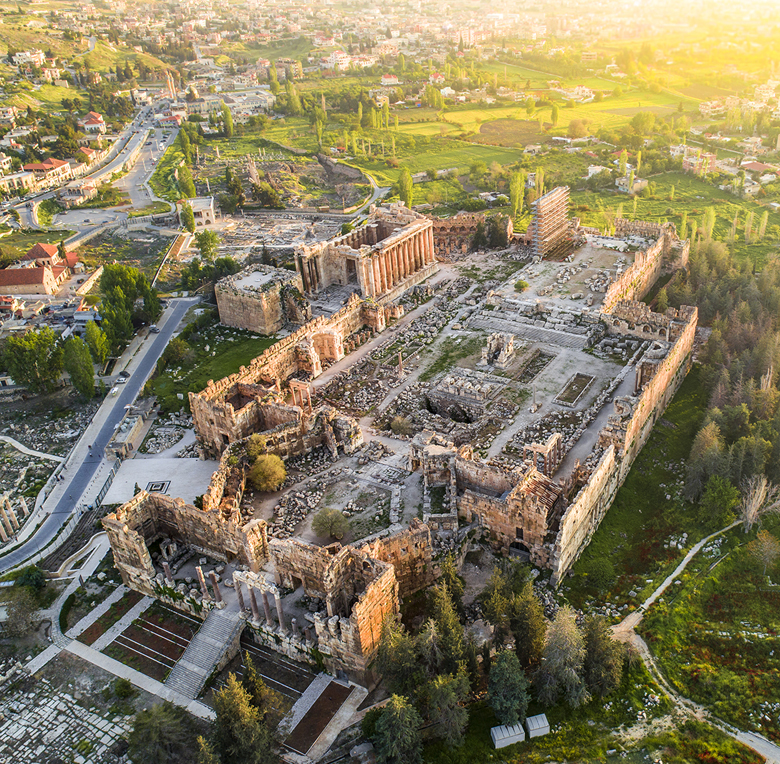
Photo – Rami Rizk
The city’s history spans back to the early Phoenician times and crosses into the reign of Alexander the Great. Like much of Lebanon, the resilience of the ruins in the face of destruction is part of what gives them their beauty. Through multiple empires, rulers, and wars, the temples have managed to not only survive but to keep their magnificence and grandeur intact.
Getting there
Take the Beirut-Damascus Highway out of Beirut towards Zahle , and follow the signs to Baalbeck.
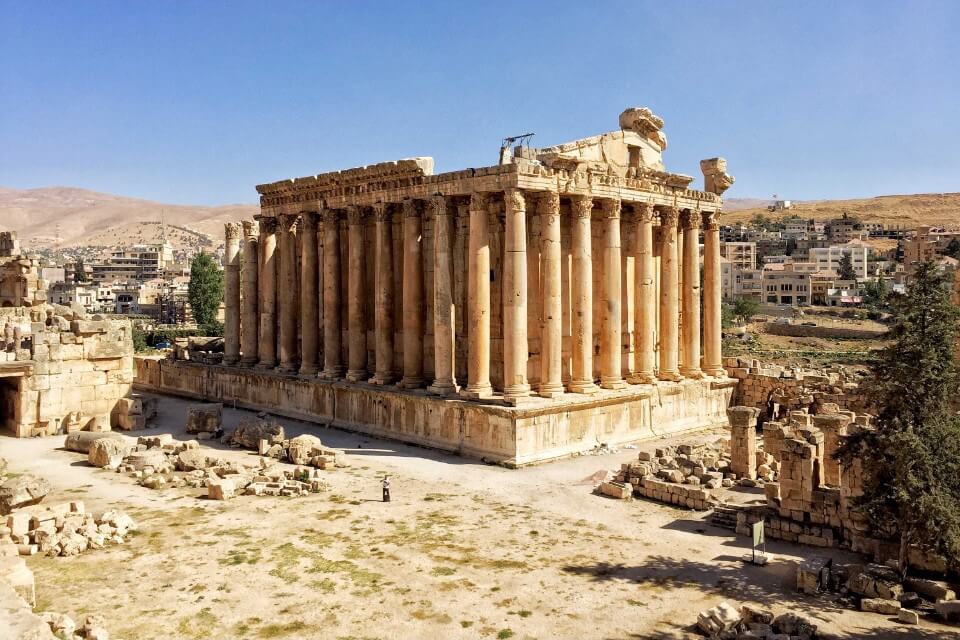
Photo – Jubran Elias
Baalbeck Archaeological Site
Though the Temple of Bacchus is the site’s largest ruin, there are actually three ancient temples at the Baalbeck Archaeological Site—the Temple of Venus, Jupiter, and Bacchus. The Temple of Jupiter originally featured 54 of the largest columns in the world, some of which can still be seen today. The Temple of Bacchus is easily one of the best-preserved remains of a Roman temple in the world. It is rumored that its halls were once used for human sacrifice. The mammoth structure took 120 years and 100,000 slaves to construct, and today, its glory is a reminder of the history buried deep within Lebanon’s past.
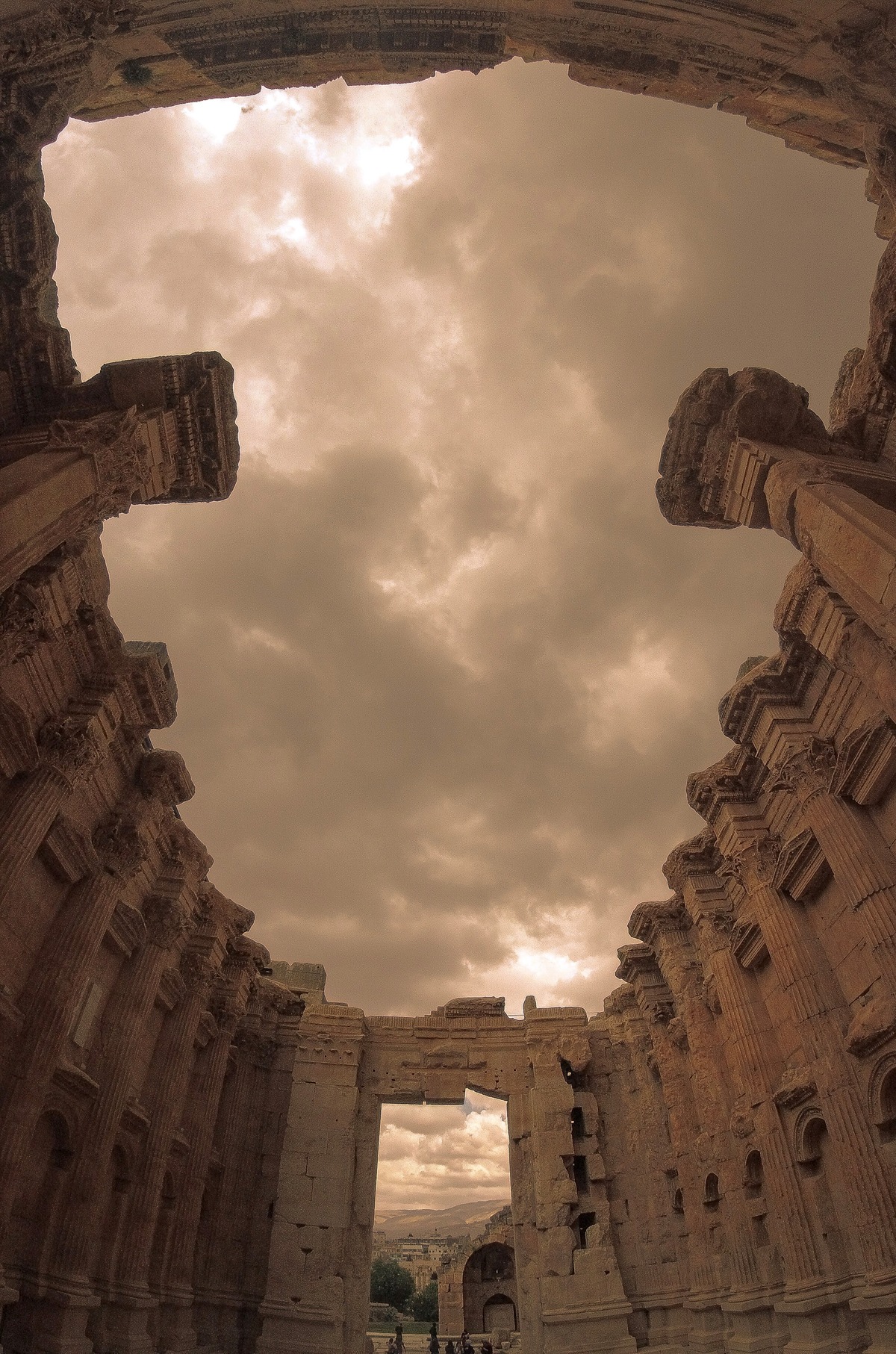
Photo – Ragheb Ismail
The sheer size of the Baalbeck Temple is enough to astound visitors. Its ancient columns loom high overhead and support an intricately decorated roof. The carving throughout the temple depicts Roman scenes and history-buffs will enjoy recognizing famous gods and goddesses in the artwork. Take your time meandering these ancient grounds, they are some of the best in the world. The site is open from 8:30 am daily. For more information, call +961 8 370 520 .
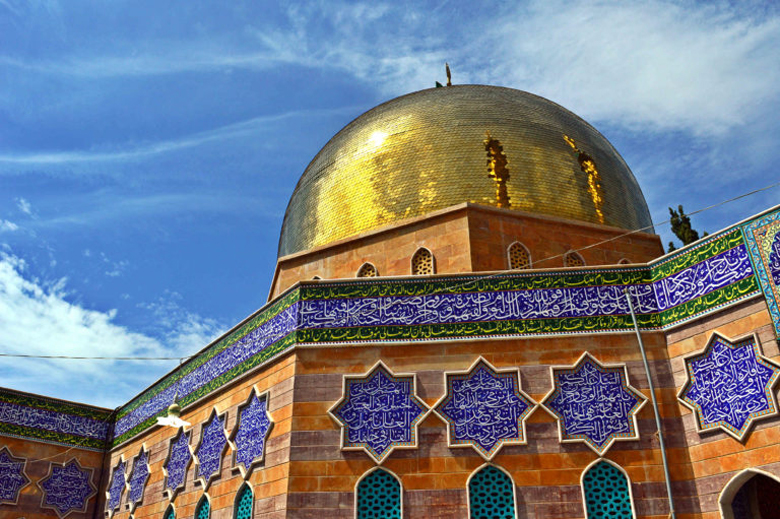
Photo – Ani Anywhere
Sayyida Khawla Shrine
The shrine of Sayyida Khawla, daughter of Imam Hussein and great-granddaughter of Prophet Muhammad, is located at the southern entrance of the city. Though the stories vary, it is commonly believed that Our Lady of Baalbeck was laid to rest among the orchards, where her shrine stands today. Stories also claim that people residing close to her shrine have seen divine lights shining between the orchards.
Stone of the Pregnant Woman
This Roman artifact is one of the largest monoliths to be excavated. The exact method used to carve this stone is somewhat of a mystery. As for its name, there are several stories behind it; one story claims its name is attributed to the stone’s ability to increase fertility, while others stipulated it was because of a pregnant woman who claimed she could remove the rock if she was fed.
Baalbeck International Festival
Every summer, Bacchus Temple transforms into a unique venue welcoming the biggest names in opera, jazz, rock, pop, and dance for the Baalbeck International Festival. Artists including Fairuz, Sting, and Charles Aznavour have been among the festival’s special guests. It is certainly an important cultural event for the country. For more information, visit baalbeck.org.lb .
Where to Eat
There are several restaurants just outside the Baalbeck Archaeological Site that offer great mezze and will sustain you for the rest of the day. Try the Baalbeck Palace ( +961 8 377 666 ) or Ananas Restaurant ( +961 81 616 406 ), both of which are within walking distance from the site. Simply ask a local guide to point you in the right direction, since their signage is in Arabic. One thing’s for sure, though: one cannot go to Baalbeck and not try their famous sfiha Baalbackieh .
Where to Stay
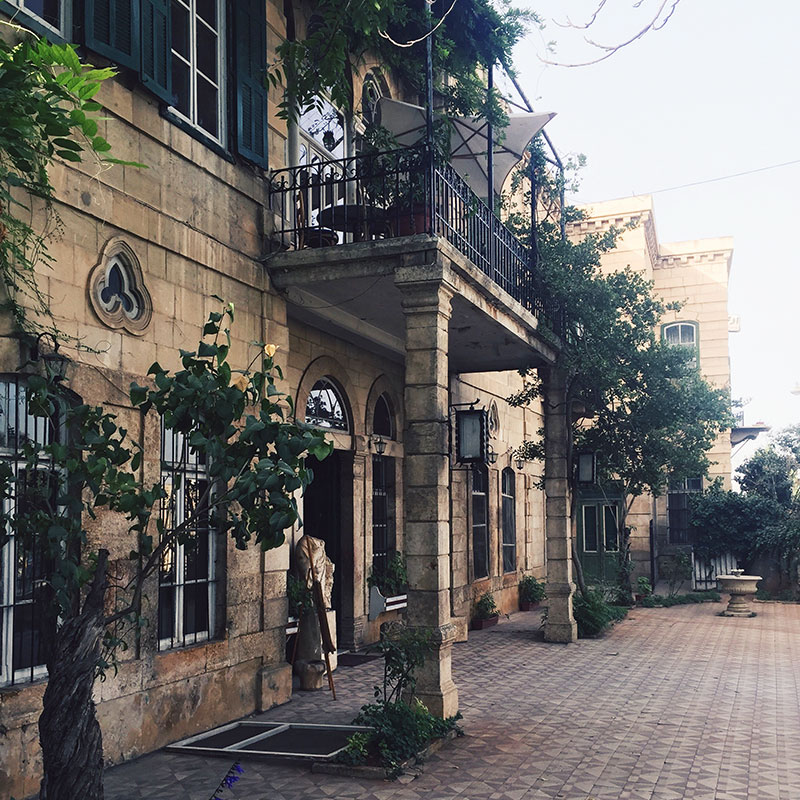
Hotel Palmyra
Located steps from the Baalbeck ruins, the historic Hotel Palmyra ( +961 3 371 127 ) is a beautifully renovated house, complete with terraces, a sunny garden, and a lovely restaurant. The hotel has been open since the 19th century, and has seen its fair share of celebrities, including Nina Simone, Ella Fitzgerald, and even Charles de Gaulle. Today, the hotel is decorated with authentic vintage décor and furniture that is reminiscent of old Lebanese grandeur. Some rooms even offer a view of the nearby Roman ruins. The service, rooms, and overall ambience will make you feel immediately welcome and enamored with Baalbeck’s charm .
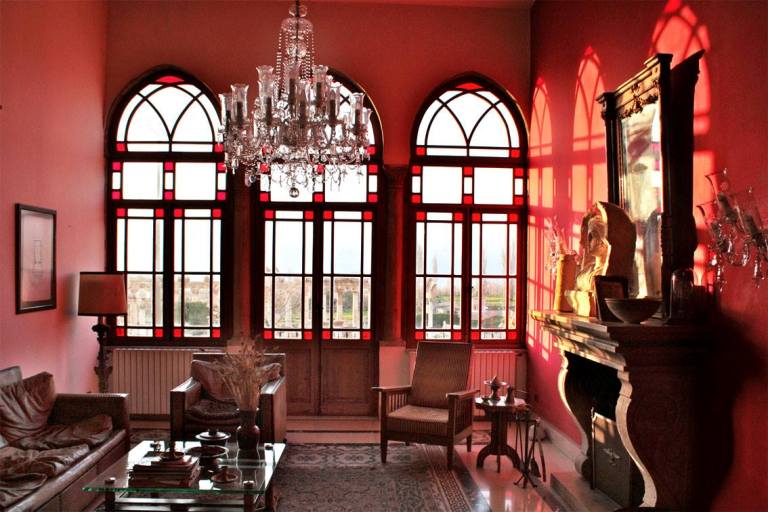
L’Annexe
L’Annexe ( +961 81 064 460 ) is a traditional Lebanese home built in the 19th century that includes five rooms and a patio. Light passes through its arched windows, filling the quarters with an ochre glow. The patio combines colorful fabrics inspired by Arab motifs with the tranquility of a Greek island garden.
Ali and his wife, Rima, acquired the place in the 1980s and opened L’Annexe’s doors to share their passion for this forgotten city with anyone thirsty for a true voyage into Middle Eastern heritage.
Article published on September 17, 2021.
Article edited on October 3, 2021.
Behind the Scenes with Beirut Contemporary Ballet
Christine safa paints her journey from lebanon to paris, you may also like, experience the best of keserwan, 10 hidden destinations in lebanon that you must..., water sports to challenge your inner adrenaline junkie, where to dine by waterfalls, rivers and lakes..., beit jedde: mtein’s magical guesthouse and community project, more than a winery: ardoum in magical mtein, unlocking the beauty of jbeil, from beirut to batroun by bike, unlocking the beauty of deir el ahmar, 5 captivating lakes, leave a comment cancel reply.
Save my name, email, and website in this browser for the next time I comment.
- 2 Get around
- 6.1 Pastries
<a href=\"https://tools.wmflabs.org/wikivoyage/w/poi2gpx.php?print=gpx&lang=en&name=Baalbek\" title=\"Download GPX file for this article\" data-parsoid=\"{}\"><img alt=\"Download GPX file for this article\" resource=\"./File:GPX_Document_rev3-20x20.png\" src=\"//upload.wikimedia.org/wikipedia/commons/f/f7/GPX_Document_rev3-20x20.png\" decoding=\"async\" data-file-width=\"20\" data-file-height=\"20\" data-file-type=\"bitmap\" height=\"20\" width=\"20\" class=\"mw-file-element\" data-parsoid='{\"a\":{\"resource\":\"./File:GPX_Document_rev3-20x20.png\",\"height\":\"20\",\"width\":\"20\"},\"sa\":{\"resource\":\"File:GPX Document rev3-20x20.png\"}}'/></a></span>"}'/> Baalbek بَعلبَك is one of the most spectacular archaeological sites in Lebanon and one of the country's UNESCO World Heritage Sites . Baalbeck or 'Heliopolis' as it was known is the site of great ancient temples built by the Phoenicians, the Romans , and other civilisations that have conquered the region and enjoyed the fertile soil of the Bekaa Valley . Some of the most celebrated temples are the ones of Bacchus, the Greek god of wine, and Jupiter, the Roman god of light, of the sky and weather.
Buses to Baalbek from Beirut leave the Cola intersection frequently and cost 7,000 LL. During the summer season daily tours are available from Beirut to Baalbeck from most major hotels; tour operator Nakhal has a guided coach tour several days a week for US$70. The trip takes about two hours each way.
It is possible to travel from Homs in Syria to Baalbek by bus. Buses leave from the Karnak or Luxury coach stations in Homs and cross into Lebanon at al-Qa'a, arriving soon thereafter at Baalbek. Cost is about US$10.
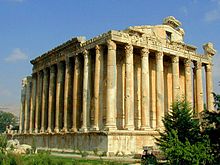
Visiting the ruins of Baalbeck costs 15 000 LL. The ruins consist of several temples and buildings:
- Temple of Bacchus (Small Temple) .
- Temple of Jupiter . 1st century AD.
- Great Court .
- Temple of Venus .
- Hexagonal Forecourt .
- Hajar al-Hubla . When you visit Baalbeck, be sure to drop by Abd an-Nabi al-Afi, the fellow who is caretaker to possibly the largest cut stone to be found anywhere on Earth (Hajar al-Hubla). He's working hard to clean up the environment a little bit, and he even offers tours of the area. Ask him to take you to the cafe up on the hill for an evening view of the valley.
- Every summer the Baalbeck International Festival offers performances from local and international artists. In the past performers ranged from Sting, Vanessa Mae and Phil Collins to plays by the celebrated Lebanese Rahbani brothers.
Do not buy antiquities as they are most likely fake. This is the center of the fake coin industry. Insist on a certificate of authenticity, and pay by credit card and keep your receipt. At least then you can charge back the dealer when you learn you have been deceived. Real antiquities could also be from illegal digs, don't buy them either.
You will probably also be touted some yellow Hezbullah T-shirts while you are at Baalbeck, as it is the birthplace of that party. If you choose to buy one beware: these T-shirts will self-destruct in the laundry, losing all of their green ink in the wash. That aside, they are an interesting souvenir. They should only cost 1,000 LL, not the 15,000 LL they'll ask.
Oriental pastries are offered by Patisserie Jawhari, there you can find traditional sweets from Lebanon, Syria and Turkey. The most famous sweet there is called "namoura bel ashta" (namoura with cream). The cream is extracted from fresh boiling milk. More pastries are found including knefe and neqlawa.
Every summer there are outdoor sheesha bars, they also serve food, drinks, desserts.
- 34.003103 36.203941 2 L'Annexe . Located next to Hotel Palmyra, this small boutique hotel offers just five rooms. However, the whole building is renovated and the hotel offers a service way and above that of its bigger cousin nextdoors. Prices from $110 . ( updated Aug 2017 )
- 34.00489 36.205891 3 Jammal Hotel . Budget hotel with spacious rooms on the city's main street near the ruins. Single rooms for US$20 . ( updated May 2018 )
- UNESCO World Heritage Sites
- UNESCO tag to be fixed
- Has custom banner
- See listing with no coordinates
- Has map markers
- Do listing with no coordinates
- Outline parks
- Outline articles
- Park articles
- Has Geo parameter
- All destination articles
- Pages with maps
Navigation menu
Most popular inspiration
Most popular experiences
Most popular destinations
Most popular itineraries
Travel bucket list idea:
Baalbeck, Baalbek-Hermel Governorate, Lebanon
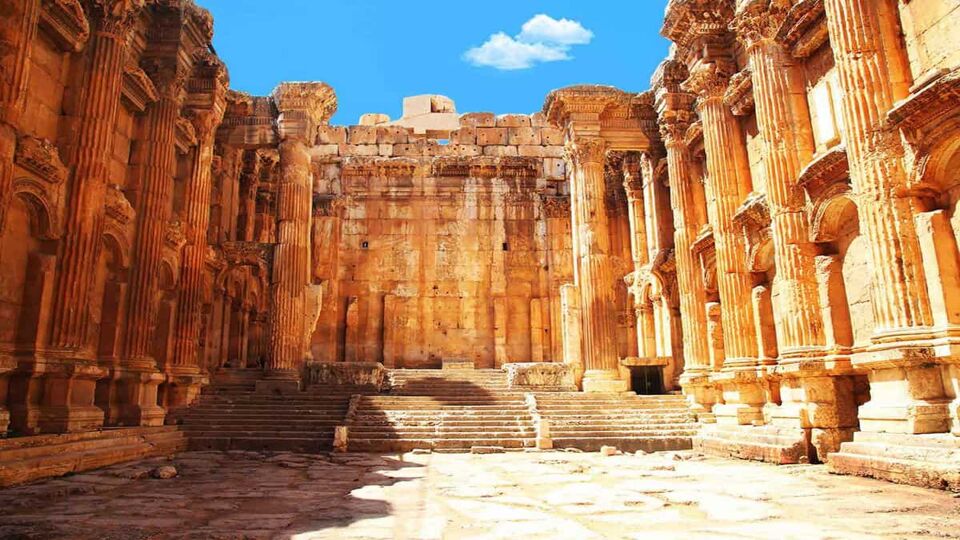
This exceptional Roman temple complex is one of the best-preserved examples of Roman architecture in the world.
Situated on a hill overlooking the surrounding valley, the enormous site includes the remains of two exceptional Roman temples – the Temple of Bacchus and the Temple of Jupiter, the latter distinguished by its 6 remaining columns. Both date from the mid-1st century – the height of the Roman Empire.
The site was known as ‘Heliopolis’ (meaning Sun City in Greek) during Roman times, though it had been a site of worship since 8,000 BC. The current name derives from the Phoenician sky god, Baal; the Phoenicians (1500 BC – 300 BC) built the first significant temple here.
Getting there & doing it
The temple complex lies in the middle of the town of Baalbek, about 85km north-east of Beirut.
This is considered ‘Hezbollah territory’, it’s wise to go with a tour group or private driver who’s familiar with the area.
As there’s very little signage around the ruins, a tour guide can be very useful here. Many guides offer their services at the entrance for a small fee.
There are no stalls or restaurants inside the temple complex, so eat beforehand and bring plenty of water as the site involves quite a bit of walking.
When to do it
The site is open year-round daily, from dawn to dusk.
If you have the chance to go outside high season (July-August) you may very well end up having the place almost to yourself, which is an incredible experience.
High summer is uncomfortably hot, with temperatures close to 40°C, and unpleasantly busy.
Who to go with: tour operators
Our writer’s recommended tour operators to book with
YellowWood Adventures [Lebanon]
London, United Kingdom (UK)
![baalbek lebanon visit YellowWood Adventures [Lebanon]](https://cxgveiouca.cloudimg.io/familyhotelfinder.com/wp-content/uploads/YellowWood-Adventures.jpg?w=350&h=220&func=cover)
TourOperator
Well-regarded tour operator specialising in small group and private/bespoke tours to the undiscovered parts of Lebanon, including Baalbeck. They’re renowned for cultural & hiking tours that take the ‘lesser known path’, avoiding the crowds, but still taking in the main sights.
You may also like…

50 Best Roman ruins to visit
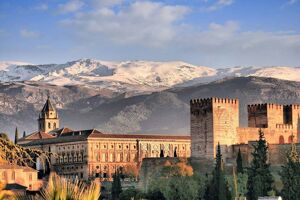
100 World’s greatest historic buildings

50 Must-see ancient sites & ruins of lost civilisations
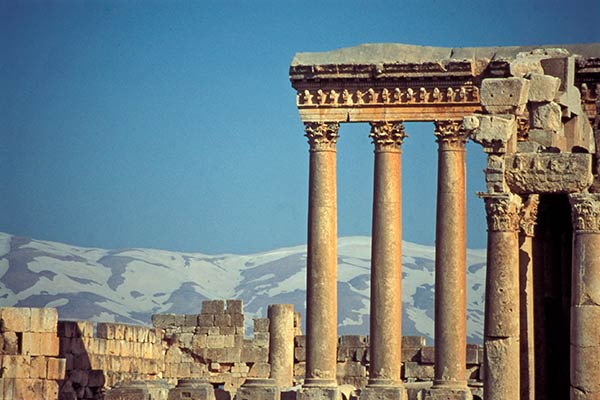
Approximately 86 kilometers northeast of the city of Beirut in eastern Lebanon stands the temple complex of Baalbek. Situated atop a high point in the fertile Bekaa valley, the ruins are one of the most extraordinary and enigmatic holy places of ancient times. Long before the Romans conquered the site and built their enormous temple of Jupiter, long even before the Phoenicians constructed a temple to the god Baal, there stood at Baalbek the largest stone block construction found in the entire world.
The origin of the name Baalbek is not precisely known and there is some difference of opinion among scholars. The Phoenician term Baal (as the Hebrew term Adon) simply means ‘lord’ or ‘god’ and was the title given to the Semitic sky-deity worshipped throughout the archaic Middle East. The word Baalbek may mean 'God of the Bekaa valley' (the local area) or ‘God of the Town’, depending on different interpretations of the word. Ancient legends assert that Baalbek was the birthplace of Baal. Some scholars have suggested that Baal (the Assyrian Hadad) was only one of a triad of Phoenician deities that were once venerated at this site - the others being his son Aliyan, who presided over well-springs and fecundity, and his daughter Anat (Assyrian Atargatis).
In the Seleucid (323-64 BC) and Roman (64 BC-312 AD) periods, the town became known as Heliopolis , the ‘City of the Sun.' The sky/sun god Jupiter became the central deity of the shrine during this time. Arguably the most important deity of the Romans and taking over the role of Zeus in the Greek pantheon, Jupiter was probably chosen to replace the much earlier worship of the Phonecian god Baal who had many characteristics in common with the Greek Zeus. Many Roman emperors were of Syrian birth, so it would not have been unusual for them to have promoted the worship of the country's indigenous deities under their adopted Roman names. Whatever the nature of the pre-Roman worship at Baalbek, its veneration of Baal created a hybrid form of the god Jupiter, generally referred to as Jupiter Heliopolitan. The Romans also assimilated the worship of the goddess Astarte with that of Aphrodite or Venus, and the god Adonis was identified with Bacchus.
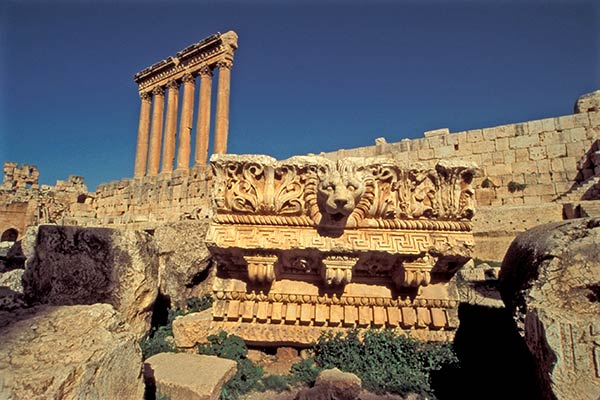
The origin and development of Baalbek may be considered from two quite different paradigms of prehistory, one the conventional approach that views civilization as having only begun in middle Neolithic times and the alternative approach which suggests that developed cultures existed in what is archaeologically known as the Paleolithic period. Let us first examine the chronology of Baalbek from the conventional interpretation, following which I will discuss some amazing site anomalies that can only be explained by recourse to a far older and now lost civilization.
According to theories stated by the mainstream archaeological community, the history of Baalbek reaches back approximately 5000 years. Excavations beneath the Great Court of the Temple of Jupiter have uncovered traces of settlements dating to the Middle Bronze Age (1900-1600 BC) built on top of an older level of human habitation dating to the Early Bronze Age (2900-2300 BC). Biblical passages (I Kings, IX: 17-19) mention the name of King Solomon in connection with a place that may be ancient Baalbek (“And Solomon built Gezer and Beth-Horon, the lower, and Baalath and Tadmor in the wilderness”), but most scholars are hesitant to equate this Baalath with Baalbek and therefore deny any connection between Solomon and the ruins. Because the great stones of Baalbek are similar, though far larger, than the stones of the temple of Solomon in Jerusalem, archaic myths had arisen that Solomon erected both structures. If Solomon had really erected the site of Baalbek, however, it is astonishing that the Old Testament has mentioned nothing of the matter.
After the time of Solomon, the Phoenicians became masters of Syria and chose the site of Baalbek for a temple to their Sun-god Baal-Hadad. Little is known of Baalbek from this period. The late 11th century BC witnessed the arrival of an Assyrian army on the Mediterranean coast but because Baalbek is not mentioned alongside the names of other Phonecian cities, it has been assumed that Baalbek was an obscure religious center with no political or trading importance.
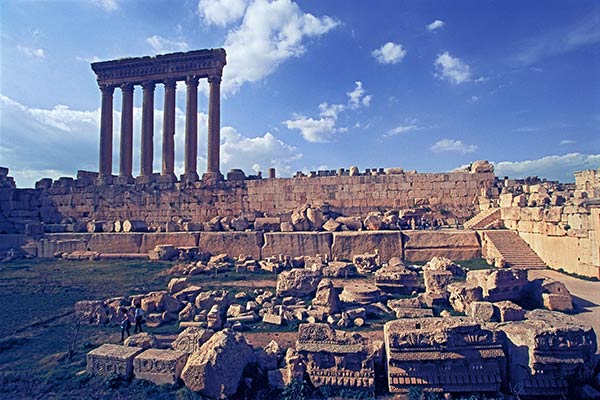
The first-century AD Jewish historian Josephus tells of Alexander's march through the Beqa'a on his way to Damascus, during which he encountered the city of Baalbek. Following the death of Alexander in 323 BC, Phoenicia was ruled successively by the Ptolemaic kings of Egypt and the Seleucid kings of Syria until the arrival of the Romans. The name Heliopolis, by which Baalbek was known during Greco-Roman times, derives from Greek association with the site beginning in 331 BC. Meaning ‘City of the Sun’, the name was also used by the Ptolemies of Egypt between 323 and 198 BC, in order to express the importance this holy site held for the Egyptians. A sacred site with this same name already existed in Egypt and the new Ptolomaic rulers may have found it provident to link the ancient sky-god of Baalbek with the Egyptian god Re and the Greek Helios in order to establish closer religious and cultural ties between their newly established Ptolomaic dynasty in Egypt and the eastern Mediterranean world. In the historical writings of Ambrosius Theodosius Macrobius, a Latin grammarian who lived during the 5th century AD, the god of the holy place was called Zeus Heliopolitanus (a Greek god) and the temple was mentioned as a place of oracular divination, similar to such sites as Delphi and Dodona in Greece and the temple of Amun at Siwa in Egypt.
The golden age of Roman building at Baalbek/Heliopolis began in 15BC when Julius Caesar settled a legion there and began construction of the great Temple of Jupiter. During the next three centuries, as emperors succeeded one another in the imperial capital of Rome, Heliopolis would be filled with the most massive religious buildings ever constructed in the far reaching Roman Empire. These monuments functioned as places of worship until Christianity was declared the official religion of the Roman Empire in 313 AD, following which the Byzantine Christian emperors and their rapacious soldiers desecrated thousands of pagan sanctuaries. At the end of the 4th century, Emperor Theodosius destroyed many significant buildings and statues, and constructed a basilica with stones from the Temple of Jupiter. This signaled the end of Roman Heliopolis. The city of the sun declined and lapsed into relative oblivion.
In the year 634, Muslim armies entered Syria and besieged Baalbek. A mosque was built within the walls of the temple compound, which was itself converted into a citadel. Over the next several centuries, the city and region of Baalbek were controlled by various Islamic dynasties including the Umayyads, Abbasids and Fatamids as well as the Seljuk and Ottoman Turks. During these years, Baalbek was ravaged by the Tartars in 1260, Tamerlane in 1401 and was also shaken by numerous powerful earthquakes.
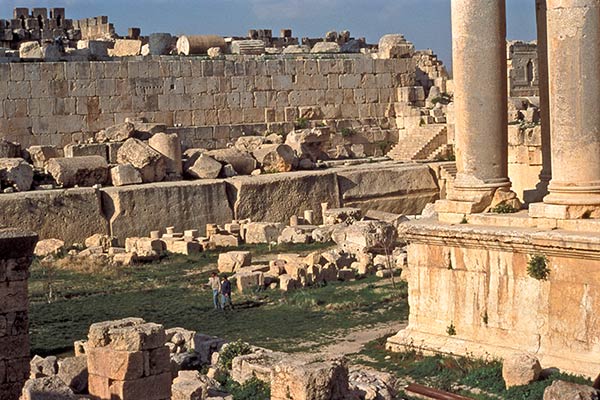
In the 1700’s, European explorers began to visit the ruins and in 1898 the German emperor, William II organized the first restoration of the ancient temples. Following the lead established by the Germans, extensive archaeological excavations were carried out by the French government and later the Lebanese Department of Antiquities. While a great deal of much needed restoration work was performed by these archaeologists, the analysis of the ancient origins and use of the site was limited by the prevailing academic view of prehistory which does not recognize the possibility of sophisticated civilizations in early Neolithic or pre-Neolithic times. Particular structures at the Baalbek ruins can, however, only be explained by recourse to such extremely ancient cultures.
The ruins of Baalbek, situated on a large hill (1150 meters) with an expansive view over the adjoining plains, are bordered on two sides by the town of Baalbek and on the other sides by agricultural land belonging to local farmers. Within the sprawling complex are a profusion of temples and platforms filled with a stunning collection of fallen columns and sculptures. The primary structures at the ruins are the Great Court; the Temple of Baal/Jupiter situated upon the massive pre-Roman stone blocks known as the Trilithon; the so-called Temple of Bacchus; and the circular temple believed to be associated with the goddess Venus. Let us briefly discuss the Roman constructions first.
The Great Court, begun during the reign of Trajan (98-117), measured 135 meters by 113 meters, contained various religious buildings and altars, and was surrounded by a splendid colonnade of 128 rose granite columns. These magnificent columns, 20 meters tall and of enormous weight, are known to have been quarried in Aswan, Egypt but how they were actually transported by land and sea to Baalbek remains an engineering mystery. Today, only six columns remain standing, the rest having been destroyed by earthquakes or taken to other sites (for example, Justinian appropriated eight of them for the basilica of Hagia Sophia in Constantinople).
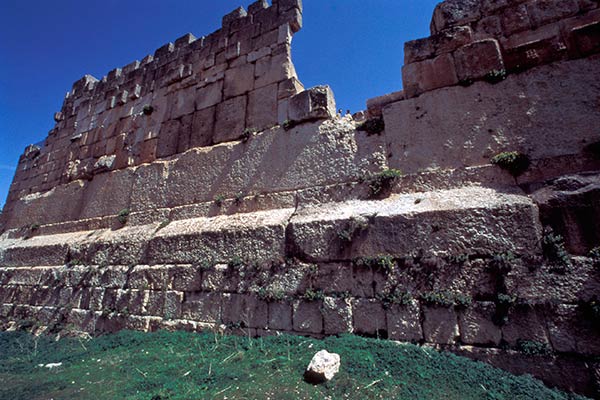
The Temple of Baal/Jupiter was begun during the reign of Emperor Augustus in the late first century BC and completed soon after 60 AD. The single largest religious edifice ever erected by the Romans, the immense sanctuary of Jupiter Heliopolitanus was lined by 104 massive granite columns, imported from Aswan in Egypt, and held a temple surrounded by 50 additional columns, almost 19m (62ft) high. The Temple is believed to have been consecrated to a triad of deities: Hadad (Baal/Jupiter), the god of Heaven; Atargates (Astarte/Hera), the wife of Hadad; and Mercury, their son.
As the vast temple complex expanded throughout Roman times, the so-called Temple of Bacchus was constructed in the middle of the 2nd century BC. It is called the Temple of Bacchus (the god of fertility and good cheer) mainly because a number of its sculptured reliefs have been interpreted by archaeologists as scenes from the childhood of this god (although some scholars argue this temple was dedicated to Mercury, the winged god of communication). The best-preserved Roman temple in the world, it is sixty-nine meters long by thirty-six meters wide and is surrounded by forty-two columns nineteen meters in height.
At the beginning of the 3rd century a lovely circular temple was added to the Baalbek complex. While early European visitors assumed it was a Venus temple due to its ornamentation of seashells, doves and other artistic motifs associated with the cult of this goddess, it is not known for certain which deity the shrine was actually dedicated to. During Byzantine Christian times the temple was used as a church by Greek Catholics and dedicated to the early Christian martyr Saint Barbara.
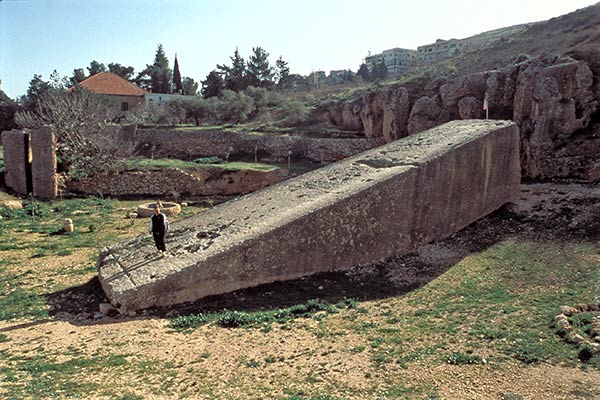
The great mystery of the ruins of Baalbek, and indeed one of the greatest mysteries of the ancient world, concerns the massive foundation stones beneath the Roman Temple of Jupiter. The courtyard of the Jupiter temple is situated upon a platform, called the Grand Terrace, which consists of a huge outer wall and a filling of massive stones. The lower courses of the outer wall are formed of huge, finely crafted and precisely positioned blocks. They range in size from thirty to thirty three feet in length, fourteen feet in height and ten feet in depth, and weigh approximately 450 tons each. Nine of these blocks are visible on the north side of the temple, nine on the south, and six on the west (others may exist but archaeological excavations have thus far not dug beneath all the sections of the Grand Terrace). Above the six blocks on the western side are three even larger stones, called the Trilithon, whose weight exceeds 1000 tons each. These great stones vary in size between sixty-three and sixty-five feet in length, with a height of fourteen feet six inches and a depth of twelve feet.
Three other even larger monoliths are found in a limestone quarry a quarter of a mile from the Baalbek complex. The first, called the Stone of the Pregnant Woman (Hadjar el Hibla in Arabic) or Stone of the South (Hadjar el Gouble in Arabic) is sixty-nine feet by sixteen feet by thirteen feet ten inches and weights an estimated 1000 tons. This stone lays at a raised angle with the lowest part of its base still attached to the quarry rock as though it were almost ready to be cut free and transported to its presumed location next to the other stones of the Trilithon. A second stone was discovered nearby in the 1990’s and weighs an estimated 1200 tons. A third, only recently discovered beneath the Stone of the Pregnant Woman, may exceed 1200 tons but its size and weight are estimates because its base has not yet been excavated.
Why these stones are such an enigma to contemporary scientists, both engineers and archaeologists alike, is that their method of quarrying, transportation and precision placement is beyond the technological ability of any known ancient or modern builders. Various ‘scholars’, uncomfortable with the notion that ancient cultures might have developed knowledge superior to modern science, have decided that the massive Baalbek stones were laboriously dragged from the nearby quarries to the temple site. While carved images in the temples of Egypt and Mesopotamia do indeed give evidence of this method of block transportation - using ropes, wooden rollers and thousands of laborers - the dragged blocks are known to have been only 1/10th the size and weight of the Baalbek stones and to have been moved along flat surfaces with wide movement paths. The route to the site of Baalbek, however, is up hill, over rough and winding terrain, and there is no evidence whatsoever of a flat hauling surface having been created in ancient times.

Next there is the problem of how the mammoth blocks, once they were brought to the site, were lifted and precisely placed in position. It has been theorized that the stones were raised using a complex array of scaffolding, ramps and pulleys which was powered by large numbers of humans and animals working in unison. An historical example of this method has been suggested as the solution for the Baalbek enigma. The Renaissance architect Domenico Fontana, when erecting a 327-ton Egyptian obelisk in front of St Peter's Basilica in Rome, used 40 huge pulleys, which necessitated a combined force of 800 men and 140 horses. The area where this obelisk was erected, however, was a great open space that could easily accommodate all the lifting apparatus and the men and horses pulling on the ropes. No such space is available in the spatial context of how the Baalbek stones were placed. Hills slope away from where lifting apparatus would need to have been placed and no evidence has been found of a flat and structurally firm surface having been constructed (and then mysteriously removed after the lifting was done). Furthermore, not just one obelisk was erected but rather a series of giant stones were precisely put in place side-by-side. Due to the positioning of these stones, there is simply no conceivable place where a huge pulley apparatus could have been stationed.
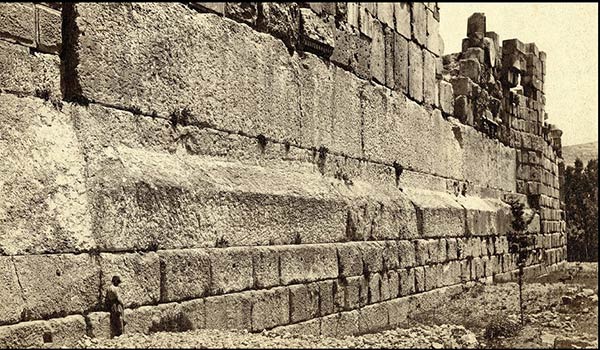
Archaeologists, unable to resolve the mysteries of the transportation and lifting of the great blocks, rarely have the intellectual honesty to admit their ignorance of the matter and therefore focus their attention solely on redundant measurements and discussions regarding the verifiable Roman-era temples at the site. Architects and construction engineers, however, not having any preconceived ideas of ancient history to uphold, will frankly state that there are no known lifting technologies even in current times that could raise and position the Baalbek stones given the amount of working space. The massive stones of the Grand Terrace of Baalbek are simply beyond the engineering abilities of any recognized ancient or contemporary builders.
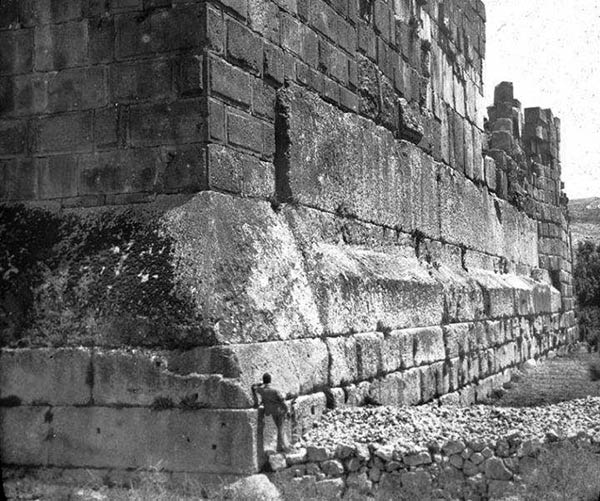
There are several other matters about the Baalbek stones that further confound archaeologists and conventional theories of prehistoric civilization. There are no legends or folk tales from Roman times that link the Romans with the mammoth stones. There are absolutely no records in any Roman or other literary sources concerning the construction methods or the dates and names of the benefactors, designers, architects, engineers and builders of the Grand Terrace. The megalithic stones of the Trilithon bear no structural or ornamental resemblance to any of the Roman-era constructions above them, such as the previously described Temples of Jupiter, Bacchus or Venus. The limestone rocks of the Trilithon show extensive evidence of wind and sand erosion that is absent from the Roman temples, indicating that the megalithic construction dates from a far earlier age. Finally, the great stones of Baalbek show stylistic similarities to other cyclopean stone walls at verifiably pre-Roman sites such as the Acropolis foundation in Athens, the foundations of Myceneae, Tiryns, Delphi and even megalithic constructions in the ‘new world’ such as Ollyantaytambo in Peru and Tiahuanaco in Bolivia.

Additional information on Baalbek at ancient-wisdom.
Andrew Collins on Baalbek
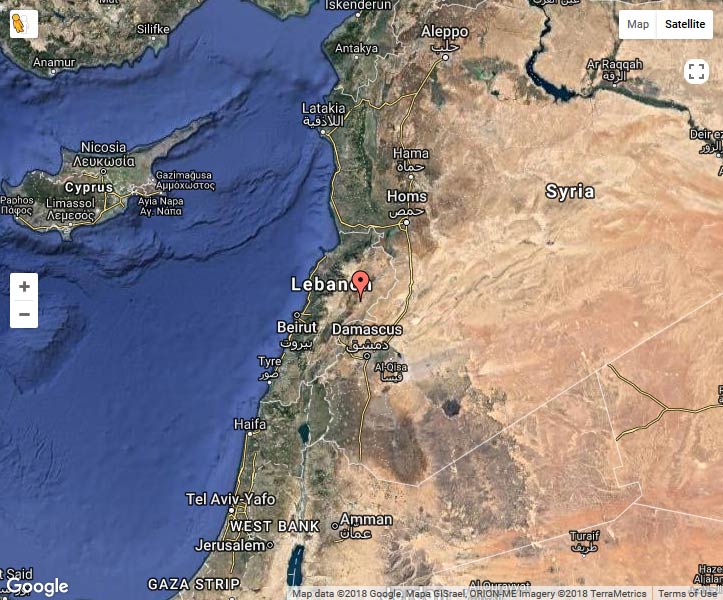
- Global Sacred Sites List
- Introduction to Sacred Places
- New and Updated
- South Africa
- Dom. Republic
- United States
- Afghanistan
- North Korea
- Philippines
- South Korea
- Turkmenistan
- Netherlands
- Switzerland
- Saudi Arabia

- ARCHITECTURE
- ARCHITECTURE GUIDES
- WINTER DESTINATIONS
- THE ISLANDS
- BOOKS ABOUT GREECE
- BOOKS ABOUT CHINA
- 3D PUZZLES OF FAMOUS BUILDINGS
How to Visit the Ruins of Baalbek on a Day Trip
Do not leave Lebanon without paying a visit to its most famous ancient site, Baalbek. The temple of Baalbek was meant to be bigger and more lavish than the Acropolis in Athens itself. According to an Arab legend, ghosts and spirits came together to build this temple in the Beqaa Valley.
However, and in spite of their efforts, they could never finish it. In reality, due to wars, earthquakes, and human negligence, Baalbek is now just a shadow of what it once was. Do not despair! What remains is truly beautiful and gives us an idea of how magnificent the temple must have been. The name Baalbek comes from the ancient god of fertility, Baal.
- 1 Day Trip to the Temple of Baalbek
- 2 From Beirut to Baalbek
- 3 What is Baalbek Town Like
- 4 Brief History of Baalbek
- 5 Visit to the Temples of Baalbek
- 6 Temple of Venus
- 7 Temple of Jupiter
- 8 Temple of Bacchus
- 9 When to Visit Baalbek
- 10 Useful Tips
- 11 Hotels in Baalbek
- 12.1 Related posts
Day Trip to the Temple of Baalbek
Though I had been to Lebanon before , Eitan hadn’t and was dying to go. As you know, we plan our trips along a route of essential places and leave free time to discover new ones. A visit to Baalbek was guaranteed! However, we were not sure how to organize our day trip to Baalbek.
Luckily, several vans a day connect Beirut with Baalbek. These wait for passengers at Cola Junction, south of the center. We took a taxi from our Radisson Blu Martinez Hotel and got there in no time. Since the vans leave when full, we waited for half an hour before our departure. No complaints, we like catching a glimpse of everyday life.
From Beirut to Baalbek
Though Beirut and Baalbek are just 50 miles (80 km) away, the journey can take up to three hours . The road is completely congested, and vans stop pretty often. Both our vans on the way to and back from Baalbek were pretty old. We were delighted to be the only foreigners amongst locals! However, both drivers drove like crazy!
It was very hot, so people would drink water and offer us some. Of course, the bottle got thrown out of the window! Some people were smoking. Everyone was busy, chatting amongst themselves or on their phones. We got the full experience and enjoyed it! Take note that most vans continue beyond Baalbek, so they don’t stop at the city center. Instead, they drop you off at a roundabout 3 miles (5 km) away from the temple.
What is Baalbek Town Like
We took an inexpensive taxi to the city center and were there in 5 minutes. There is a large parking lot, a small square and a couple of churches and mosques. Both the Temples of Jupiter and Bacchus are in the main compound. The Temple of Venus is the centerpiece of the smaller ruins and temples that lie across.
Tourist restaurants line up the pedestrian street leading to the temple’s entrance. They sell food and drinks, and torture horses and camels for your entertainment. Actually, it is the tourists that pay local people to torture horses and camels. They don’t have a choice but to oblige. Since we wanted to avoid tourists, we sat in a small restaurant on the square. We tried Lebanese delicacies and cold drinks. At all times we felt safe and taken care of. The Lebanese are great hosts!
Brief History of Baalbek
The Greeks arrived in the Egyptian city of Heliopolis in the 3rd century BC and discovered the remains of an older Phoenician settlement and renamed it Baalbek. Under the Rule of Augustus, the Romans arrived in the area around the year 15 BC. They built the Temples of Jupiter, Bacchus, and Venus in Baalbek. The Temple of Jupiter was demolished in the 4th Century when Theodosius built a Christian basilica over it.
In 643 a great earthquake destroyed the rest of the temple and the basilica. Soon after, the Arabs conquered the area and built a fortress over the temples. Baalbek’s importance was recognized again in the 20th Century, and serious reconstruction started. Of course, UNESCO had to include the temples of Baalbek in its World Heritage List in 1984.
Visit to the Temples of Baalbek
Though the small area around the Temple of Venus is out of reach, you can see it from the outside. You will find the ticket office on the main site. You enter the temple complex from the monumental Propylaea which are in pretty good shape. As soon as you climb the stairs, you reach the Hexagonal Court and after it the Grand Court .
At the top of the Grand Court, you’ll stumble upon the remaining six pillars of the Temple of Jupiter . You have to go down to get to the Temple of Bacchus , on the left. Most of the pillars and walls are still standing. The ornamental frieze is superb. The place is so pretty, that it’s used for events on special occasions. Finally, don’t forget to look for the remains of the Arab fortress and the small museum.
Temple of Venus
The Temple of Venus is to the southeast of the Altars. You will recognize it from its Corinthian tall columns and circular appearance. Notice the 5 niches on the façade. You will see doves and shells. Thanks to them, we know that the temple was dedicated to Venus. The temple is from the 3 rd Century AD.
However, the temple is well preserved because it was used as a church for a long period of time. It was the church of Saint Barbara. It’s a sad story. Her dad still worshiped the old gods. When he found out she had converted, he killed her. He was then struck by lightning. The Greek Church in the town of Baalbek is dedicated to Saint Barbara.

Temple of Jupiter
There is no way you will not see the Temple of Jupiter . It used to be the largest temple in the Roman Empire. Today, we can only see 6 massive columns. The structure was slowly dismantled as soon as the 6 th Century. Rumor has it that some of its columns were used to build Hagia Sophia in Istanbul .
The temple is to the west of the compound on top of a flight of stairs. The columns are 62 feet (19 meters) tall. They were the tallest columns in the world. Look closely at the decorations. You will see a beautiful roman lion gargoyle. These were used to collect snow. Take your time and let your mind travel in time.
Temple of Bacchus
The Temple of Bacchus is bigger than the Parthenon in Athens, Greece. It’s also in better shape. It was and still is, one of the most impressive temples in the world. You will recognize it from its 42 Corinthian columns. These are 62 feet (19 meters) tall! Without a doubt, the Temple of Bacchus is Baalbek’s biggest draw.
The decorations of the temple deserve special attention. Find the 4 sculptures of bugs that decorate the porch. Enter the temple and notice the eagle and the two cupids. Continue through the northern corridor. You will see ladies with crowns. These represent the cities that paid for the temple. More recent decorations are the signatures of German Emperor Wilhelm II and Ottoman sultan Abdul Hamid II.

When to Visit Baalbek
Try not to visit Baalbek in summer , since it can get seriously hot, as in the rest of Lebanon. We visited in early July, and it was rather hot. Though high season had started, there weren’t many tourists. It was us, independent tourists, and a few small groups with a private guide.
Since Baalbek is a historic site that charges an entry fee, don’t expect to see groups of locals even during the weekends. Consequently, you can visit Baalbek any time of the day, any day of the week, and enjoy the tranquility of this ancient beauty. There is no need to rush, especially in the heat. We had to stop frequently under a shadow to rest, and admire the temples.
Useful Tips
If you are visiting in summer, be sure to bring a hat and some sunscreen . The best thing to do is to bring your own water in a recyclable container. If you don’t, you can always buy refreshments from the restaurants. Try not to take part in the abuse of cute animals . They have feelings just like us, so carrying people on their backs is not really their cup of tea.
The temples and the views from the top are spectacular. Therefore, don’t forget your camera and take plenty of photos. If you wish, you can hire a local guide to give you a tour around the temples of Baalbek. Some of them are licensed and know a lot about their history. If you are visiting during colder months, don’t forget to bring a jacket , as it can get relatively cold.
Hotels in Baalbek
According to the British Ministry of Foreign affairs, it is safe to visit the city of Baalbek, but not its surrounding areas. Thus, for a total local experience, spend a night or two in the city. By doing so, you can be the first and the last one to visit the temples. There are two great hotels in the city of Baalbek.
The Palmyra Hotel is a beautiful old house converted into a hotel. It is located in Baalbek’s city center, five minutes away from the temples. It seems to be unavailable at the moment. The Kanaan Group Hotel is a bit away, but you can still walk to the temples. This lavish ‘nouveau riche’ style hotel offers comfortable rooms with splendid views.

Private Tour to Baalbek
Walking one day about downtown Beirut, we stumbled upon a travel agency. They offered us an organized day trip to Baalbek for 100 USD per person. Not only did it seem expensive, but it meant we would travel with a group of tourists on a tight schedule. To us, a private tour means just us and loads of time, so no, not our thing. Instead, we inquired how to get there by public bus.
That said, if you want to hire a tour, we strongly recommend the one offered by getyourguide . A couple of friends of ours who didn’t want to travel on their own hired it and had a great time. It includes hotel pick up. They use professional drivers and give you a lot of space. The whole tour lasts 4 to 6 hours.

Related posts

Some countries are all about nature. Others house outstanding cultural sites. Lebanon is one of the…

As an architect, my trip to Harran in Southeastern Turkey was a dream come true.…

Few places in the world are as impressive as the ancient city of Petra, South…
Leave a Reply Cancel reply
Your email address will not be published. Required fields are marked *
This site uses Akismet to reduce spam. Learn how your comment data is processed .
You are using an outdated browser. Please upgrade your browser to improve your experience.
Virtual Travel
A Smithsonian magazine special report
Virtual Tour Restores Baalbek’s Stunning Roman Temples to Their Former Glory
The free online experience allows users to toggle between views of the ancient Lebanese city today and as it appeared in 215 A.D.
/https://tf-cmsv2-smithsonianmag-media.s3.amazonaws.com/accounts/headshot/Livia_lg_thumbnail.png)
Livia Gershon
Daily Correspondent
:focal(742x357:743x358)/https://tf-cmsv2-smithsonianmag-media.s3.amazonaws.com/filer/09/92/09929df3-c0e8-48f9-9c84-cfa502b877e6/the_virtual_reconstruction_of_the_altar_court_copyright_of_flyover_zone_productions_and_dai.png)
Due to Covid-19 restrictions, few visitors can currently travel to Baalbek , a city in Lebanon’s Bekaa Valley that houses some of the Roman Empire’s greatest temple ruins. Luckily, a new virtual tour allows people anywhere in the world to view the site both as it appears today and as it looked at its peak in 215 A.D.
As Maghie Ghali reports for the Abu Dhabi–based National , the Lebanese Directorate of General Antiquities and the German Archaeological Institute collaborated with virtual tour company Flyover Zone to create the online experience, titled Baalbek Reborn: Temples .
“No list of the world’s most important tourist destinations would be complete without Baalbek, so you can well understand why we jumped at the opportunity to recreate Baalbek in the Roman period,” Flyover Zone founder Bernard Frischer , who previously led a similar digital reconstruction of ancient Rome , tells the National .
Baalbek, a Unesco World Heritage Site , was a Phoenician city known during the Hellenistic period as Heliopolis. Under the Roman Empire, Baalbek reached its most impressive state, housing a complex of temples built over a period of more than 200 years. Pilgrims visited the city to worship the Romanized “triad” of Heliopolis : the deities Jupiter, Venus and Mercury.

The city’s most impressive building, the sanctuary of the Heliopolitan Jupiter, boasted 65-foot-tall columns placed atop 3,000-ton stone blocks, according to Elif Batuman of the New Yorker . Other places of worship at the site included the Round Temple , which was dedicated to Venus, and an intricately decorated temple honoring Bacchus. Today, notes Unesco , Baalbek’s Temple of Mercury is mostly destroyed.
Frischer says the site was home to one of the most important oracles of the ancient world. This Baalbek prophet was dedicated to Heliopolitan Jupiter.
“Emperors consulted it,” he tells the National . “Everyone wanted to know whether they should get married, take a trip or start a business, start a war, and they all asked the oracle.”
The free app—available for computer, mobile devices and virtual reality headsets—offers interactive, 360-degree views of 38 locations in the city, reports Robert McKelvey for Al Jazeera . Users can listen to expert audio commentary in Arabic, English, French or German and call up additional images and text for more information about specific spots. They can also toggle between seeing the buildings as they appear today and as they looked almost 2,000 years ago.
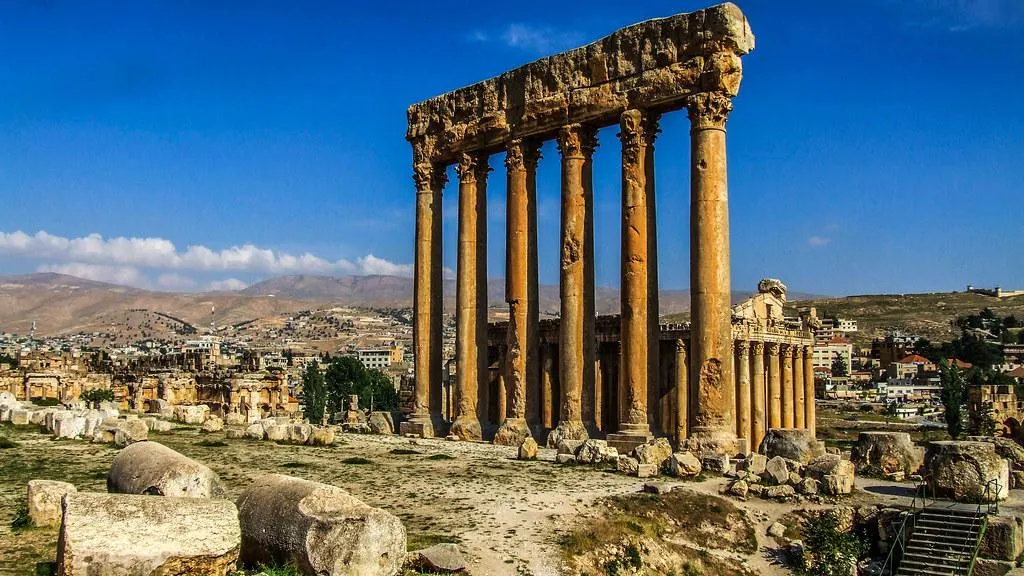
“The representation you can see will be tailored to the content of the commentary,” Henning Burwitz, a building historian and architect with the German Archaeological Institute, tells Al Jazeera . “If we explain the site today, you will see it as it looks today but if we talk about what it looked like in 215, the image will switch automatically to take you on a time travel to the year 215 and to show you what it looked like in antiquity.”
Humans have lived in the area now known as Baalbek since at least 9000 B.C. Under the Phoenicians, the city became a center for the worship of the sky-god Baal and the goddess Astarte.
Per Encyclopedia Britannica , Baalbek was controlled by Greece, Egypt and the Seleucid Empire before coming under Roman domain in the first century B.C. Between 1898 and 1903, a German expedition excavated the Roman temples. The French and Lebanese governments later cleared and repaired the site.
“There’s just something very special about the place,” Burwitz tells Al Jazeera. “It’s scientifically an extremely interesting place, being one of the more eastern Roman cities and sanctuaries. It’s quite a statement to build something like this in such a remote part of the Roman Empire.”
Get the latest stories in your inbox every weekday.
/https://tf-cmsv2-smithsonianmag-media.s3.amazonaws.com/accounts/headshot/Livia_lg_thumbnail.png)
Livia Gershon | | READ MORE
Livia Gershon is a daily correspondent for Smithsonian. She is also a freelance journalist based in New Hampshire. She has written for JSTOR Daily , the Daily Beast , the Boston Globe , HuffPost and Vice , among others.
Offbeat Travelling
Fascinating travel adventures in 'difficult' countries
December 18, 2015
Is It Safe to Visit the Baalbek Ruins in Lebanon?
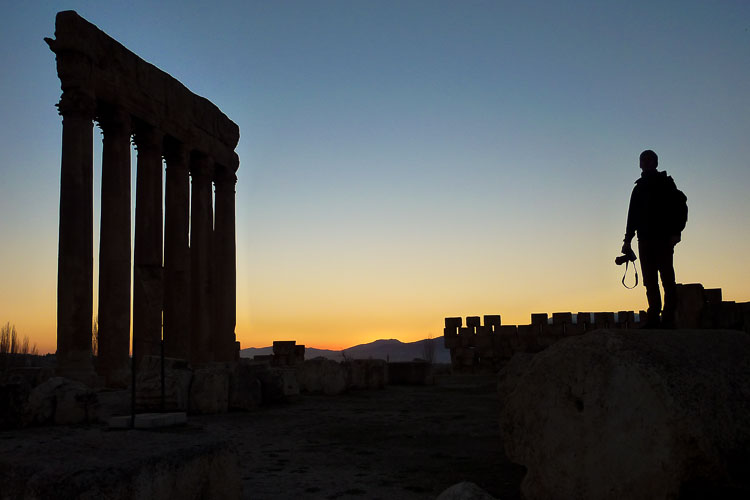
Located at the edge of Lebanon’s most troubled region, the city of Baalbek hosts the largest Roman ruins in the world. With the ongoing war in Syria just miles away, a common question is whether it is safe to visit them.
First let’s get a proper understanding of the situation around the ruins. I will go over a few recent developments.
Beqaa and the Syrian war
The Roman Ruins, sometimes referred to as Heliopolis, are located 85 kilometres northeast from Beirut in the Beqaa Valley. In the media this region has often been associated with tribal drug lords and the rule of tribal law. Though that could be true, for a traveller this will practically be of no relevance .
What is more important though, is that the city Baalbek lays north in the valley and is an important stronghold of Hezbollah. This political group is also a Shi’a Islamist militant group who are actively taking part fighting alongside the Assad regime in Syria. The main opponents they are facing in the Syrian conflict are militant groups from the Sunni denomination of Islam.
At a distance of approximately 35 kilometres lays Arsal city, which hosts a predominantly Sunni community. The mountainous Arsal region is notorious for its porous border with Syria, allowing jihadists of all sorts to get in and out of Syria in relative freedom. In 2013, rockets launched from Syria landed in the city centre of Baalbek , injuring several.
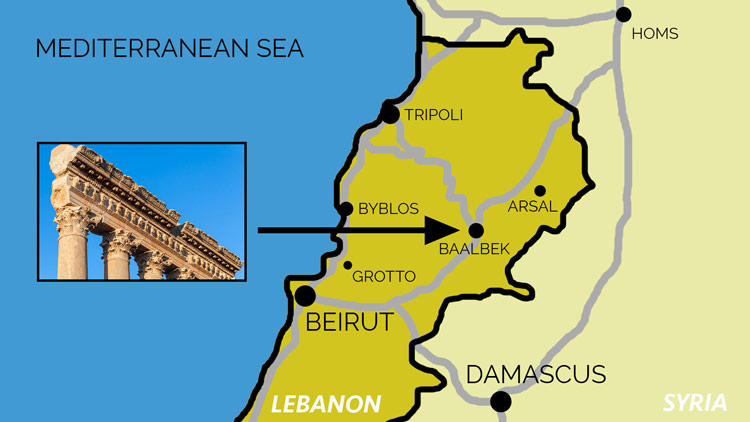
In 2014 things escalated. Sunni militant groups Al Nusra (Al-Qaeda’s Syria branch) and ISIS invaded the Arsal region, capturing dozens of Lebanese police officers and later also soldiers. After days of fighting, the Lebanese army ultimately took back control in what is now called the battle of Arsal . Prisoners of war taken on both sides of the conflict were only recently exchanged in a long-awaited swap deal that took place in Arsal on 1 December 2015. The event triggered another series of shelling and so fighting around the area continues .
READ MORE: Visiting Burj Al-Barajneh, the Site of the 2015 Beirut Bombings
There have also been threats of Sunni muslim extremists trying to enter other regions of Lebanon. On 12 November 2015, a twin suicide bombing killed dozens in the Shi’a Burj al-Barajneh neighbourhood of Beirut (which I visited just weeks after). The attack was later claimed by ISIS. In the context of all these threats there are many checkpoints by the Lebanese army in the Beqaa valley.
Baalbek ruins
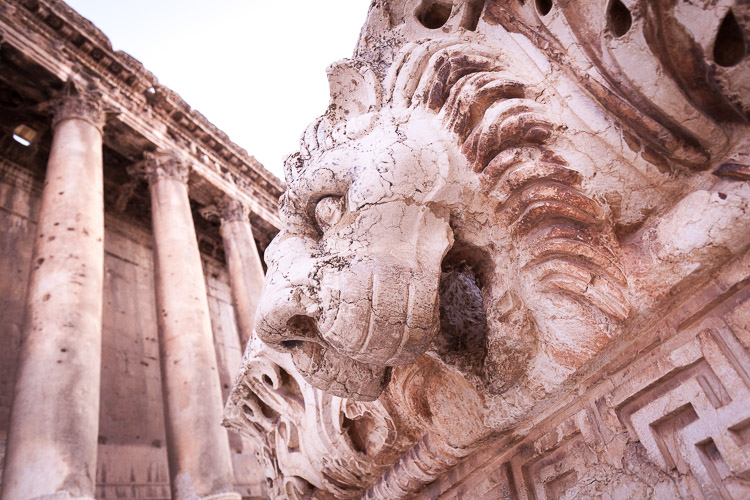
I visited the ruins 4 days after the prisoner swap, on December 5th 2015. I was together with an English friend and unfortunately we arrived quite late. As we were taking pictures of the sunset, all of the sudden we could hear the sounds of distant gunfire and shelling coming from different directions. At the exact same moment the call for prayer was broadcasted from nearby loudspeakers, making a surreal blend of sounds in the background as daylight was gradually fading away. We were not sure what was going on, but I started to record some video to keep the memory.
Note that the deep thundering sounds are clearly not from heavy gunfire (as I claim in the video), but from shelling. Later we found out that what we had been hearing was most probably the Lebanese army firing artillery at nearby Al Nusra positions. This newspaper provides proof to that theory.
So there was outgoing shelling nearby, probably at least 10km away. That would mean no direct threat for anyone visiting the Baalbek ruins.
However, there is another element of danger in the valley. One traveller who had been to the same ruins a few days later experienced a small incident involving what she called ‘celebratory gunfire’. She explained me how several men in a pickup truck were shooting assault riffles up in the air when she passed with a public minivan. The weird thing is she also explained how some other men were shooting towards the street. Now this I think is not only weird, but also very dangerous. Bullets can change direction when hitting the tarmac and it wouldn’t be the first time someone gets injured from that.
So is it safe?
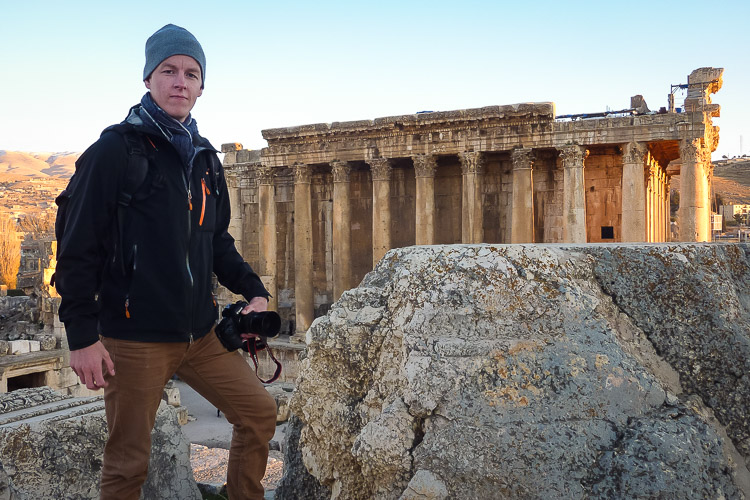
Due to the experience I and the other traveller had, I would almost discourage people from still going there. Keeping up to date with developments is not easy, especially if you are not into following international news at all.
On the other hand, I have several reports of people going there without any issues. Concerning the Syrian conflict and spillovers in the Arsal region, it seems the situation is pretty much under control. There is tension, but I don’t think it should stop you from visiting the ruins. Under normal circumstances the only thing you will experience is some checkpoints on the way, which to be honest is a normal thing in many countries.
To see if the situation around Arsal is changing at all, it is best to check Liveuamap . It offers real-time information about the Middle East conflict. Zoom in on the Lebanon-Syria border near Arsal and check (1) if the black area is still there, and (2) if there are any notifications about recent events.
Do not rely too much on your accommodation for info. I found that in Hostel Beirut the staff could not inform me about any developments, let alone safety updates. Things were better in the cheaper Talal Hotel , but facilities are more basic and the hotel has much less atmosphere. When staying in a more expensive hotel I can only imagine how they will advise hiring a private driver. I don’t believe it will increase safety but you would be able to see more things in just one day.
Do you want to learn more about travel safety in Lebanon in general? Check out this amazing post (I could not have written it better, honestly) by Joan from Against the Compass : Is it Safe to Travel to Lebanon?
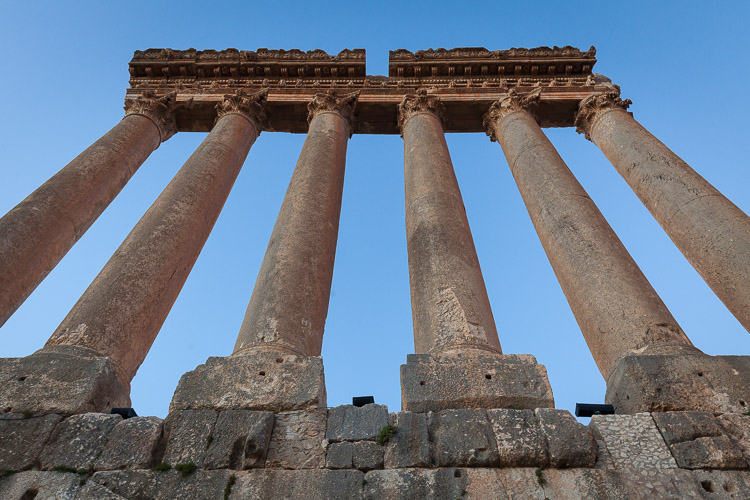
If you decide to give it a go, have a look at my directions:
How to get there
The drive from downtown Beirut to the archeological site can be done by public minivan (5000-7000 Lebanese Pounds, one-way). You can find these buses departing from ‘Cola’, which is like a big important junction in the centre of Beirut known for the Cola factory that was once there. Walking passed the big line of minivans, just ask around for the one to ‘Baalbek’.
Read more: Safety Tips for Travelling to a Potential Conflict Zone
When the driver knows that you are going to the ruins, he will drop you around a place called Douris at the outskirts of Baalbek. It takes about 3 hours to reach this place, mainly because of the military checkpoints and traffic jams while getting out of Beirut. From Douris you can then jump into a sedan-like servees towards Baalbek. It will drop you almost in front of the gate for 1000 Lebanese Pound. Be aware that some drivers will try to charge double rate to foreigners.
Another important note: try to go back to Beirut around 6-7pm latest. There are minivans driving back directly from Baalbek, but they stop operating quite early. Make sure you find the right waiting spot by asking the locals.
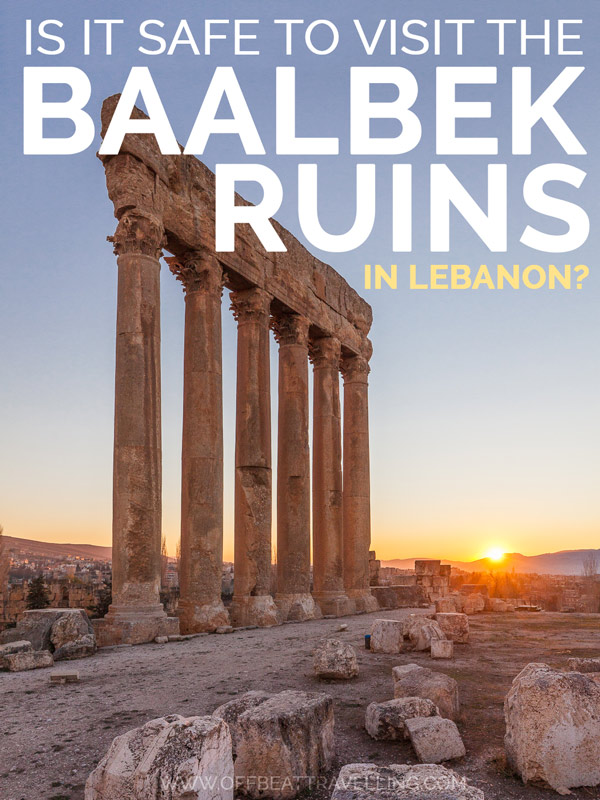
Have you been to the ruins yourself? Or are you planning to? Let me know about your experiences and advice in the comments below !
- Today's news
- Reviews and deals
- Climate change
- 2024 election
- Newsletters
- Fall allergies
- Health news
- Mental health
- Sexual health
- Family health
- So mini ways
- Unapologetically
- Buying guides
Entertainment
- How to Watch
- My watchlist
- Stock market
- Biden economy
- Personal finance
- Stocks: most active
- Stocks: gainers
- Stocks: losers
- Trending tickers
- World indices
- US Treasury bonds
- Top mutual funds
- Highest open interest
- Highest implied volatility
- Currency converter
- Basic materials
- Communication services
- Consumer cyclical
- Consumer defensive
- Financial services
- Industrials
- Real estate
- Mutual funds
- Credit cards
- Balance transfer cards
- Cash back cards
- Rewards cards
- Travel cards
- Online checking
- High-yield savings
- Money market
- Home equity loan
- Personal loans
- Student loans
- Options pit
- Fantasy football
- Pro Pick 'Em
- College Pick 'Em
- Fantasy baseball
- Fantasy hockey
- Fantasy basketball
- Download the app
- Daily fantasy
- Scores and schedules
- GameChannel
- World Baseball Classic
- Premier League
- CONCACAF League
- Champions League
- Motorsports
- Horse racing
New on Yahoo
- Privacy Dashboard
Violence rises in Lebanon - Israelis, Hezbollah fighters killed
Violence continued between Israel and the Iran-backed Lebanese Hezbollah militia on Monday, with two Hezbollah fighters and one Israeli soldier killed in attacks.
The Lebanese Health Ministry said two people had been killed in an Israeli attack on Houla and later Hezbollah said two of its fighters had been killed there.
The Israel Defense Forces (IDF) said on its Telegram channel that it had "struck Hezbollah terrorists in the area of Houla in southern Lebanon." It also hit a launcher and military structures in the areas of Ayta ash Shab and Hanine, the IDF said.
It did not comment on casualties.
Hezbollah usually does not elaborate on when, where and how its members die, but said later in a statement the dead were two of its fighters.
An Israeli soldier was killed and several others injured, one of them seriously, in a drone attack mounted on Monday from Lebanon across Israel's northern border, an IDF spokesman said.
The 45-year-old soldier was a member of the IDF's Desert Reconnaissance Battalion.
According to the spokesman, five drones armed with explosives were launched from bases operated by Hezbollah. Israel's Iron Dome defence system intercepted three of them, but two managed to get through.
Hezbollah claimed several attacks on Israeli troops and military positions in northern Israel, including a drone strike on a base and an attack on Israeli soldiers. The militia said they were trying to "infiltrate" the Lebanese border.
Meanwhile, a series of Israeli strikes targeted pro-Iranian Hezbollah-controlled areas in eastern Lebanon wounding at least eight people, security sources said.
Lebanon's Health Ministry, in a statement, said that the Israeli strikes wounded eight people, "including six Lebanese citizens, a five-year-old Syrian girl, and a fifteen-year-old Syrian girl."
The state-run news agency (NNA) said a series of airstrikes hit eastern and southern Lebanon. It said the towns in the Baalbek district were targeted by at least three Israeli air strikes.
The Israeli army said Israeli fighter jets struck a number of Hezbollah weapon storage facilities. It said secondary explosions were identified, indicating "large amounts of weapons in the facilities struck."
Since the war in the Gaza Strip began more than 10 months ago, there have been daily military confrontations between the Israeli army and the Hezbollah militia in Lebanon and other groups in the border area between the countries.
There were casualties on both sides, most of them members of Hezbollah.
Recommended Stories
Hamas political leader and hezbollah commander killed hours apart. here’s what we know about rising middle east tensions..
The leaders of two Iranian-backed groups were killed in separate attacks within 24 hours of each other this week. Here's what we know about rising Middle East tensions.
Steve Kerr compares vibe of Harris campaign at the DNC to the '90s Chicago Bulls champions
Golden State Warriors head coach Steve Kerr spoke at the Democratic National Convention Monday night at the United Center in Chicago, where he won three NBA championships as a point guard for the Chicago Bulls.
Dodgers All-Star Freddie Freeman has fractured finger on right hand, will play through it
Freeman injured the middle finger on his right hand while fielding a ground ball on Saturday.
Arsenal, Manchester City headline Premier League opening weekend, Serie A is back & more women's soccer in USA | The Cooligans
Christian Polanco and Christine Cupo recap a busy and entertaining weekend in the Premier League. They also recap action in Serie A and the German Super Cup. They also break down the new USL Super League and preview the last half of the NWSL season.
Demand for AI is driving data center water consumption sky high
The AI boom is fueling the demand for data centers and, in turn, driving up water consumption. Microsoft, a major data center operator, says 42% of the water it consumed in 2023 came from "areas with water stress." Google, which has among the largest data center footprints, said this year that 15% of its freshwater withdrawals came from areas with "high water scarcity."
What margins? AI's business model is changing fast, says Cohere founder
Aidan Gomez, CEO of competing AI provider Cohere, says that selling access to models is quickly becoming a "zero margin business" in a podcast appearance on Monday. "If you’re only selling models, for the next little while, it’s gonna be a really tricky game," said Gomez in an interview with 20VC's Harry Stebbings.
2 people arrested in Chicago before DNC kickoff as demonstrators push for Israel-Hamas war ceasefire, reproductive and LGBTQ rights protection
Protests are scheduled for each day of the DNC, which runs from Monday through Thursday night. An estimated 50,000 people are expected to be in Chicago for the convention this week.
Luxury superyacht sinks off Italy coast in freak storm. 6 people, including British tech magnate Mike Lynch, are still missing.
Six passengers are still unaccounted for after a luxury superyacht capsized off the coast of Sicily. Tech entrepreneur Mike Lynch is among those missing, along with his 18-year-old daughter.
Braves' Austin Riley expected to miss 6-8 weeks due to fractured right hand
The Atlanta Braves suffered another major injury in their lineup, with Austin Riley fracturing his right hand when he was hit by a pitch on Sunday.
11 insanely comfy throw-on-and-go dresses that don't look frumpy — from $17
The only thing better than an airy, lightweight frock is one that's affordable — take a peek at our fave maxis, minis and midis.
Tua Tagovailoa speaks candidly on difficult experience with former Dolphins coach Brian Flores
"(If) you have a terrible person that's telling you things that you don't want to hear ... you're gonna start to believe that about yourself."
Dodgers' Shohei Ohtani is nearing his first 40-40 season. When could he accomplish the feat?
Shohei Ohtani is on the verge of becoming the sixth player in MLB history to tally 40 home runs and 40 stolen bases in a season.
Waymo’s sixth-generation autonomous fleet has fewer sensors ‘without compromising safety’
Alphabet’s Waymo unveiled its sixth-generation Driver system on Monday with a more efficient sensor setup. Despite dropping the camera and LiDAR sensor counts, its new setup allegedly lowers costs while maintaining safety redundancies.
This knit jacket is better than J.Crew's coatigan, fans say — it's over 50% off
Why wait for chilly weather? This $34 polished layer will keep you toasty when the A/C is blasting.
Stanley's newest color, a subtle neutral, is giving major fall vibes
The bestselling 40-ounce Quencher tumbler is one of four cups that are getting the Almond Rose treatment.
Labor Day 2024: Everything we know, including early deals you can shop now
Labor Day weekend begins Saturday, August 31 and runs through to Monday, September 2 — but the savings have already started.
Women over 50 swear by this $12 wrinkle-zapping neck cream — and it's 25% off
'Holy moly, I see a drastic difference': Gold Bond's ultra-hydrating and firming formula has a legion of fans on Facebook.
Apple Podcasts launches on the web
Apple Podcasts can now be streamed from the web. Apple announced on Monday that its Apple Podcasts app is now available on all major web browsers (Chrome, Edge, Firefox, and Safari) in over 170 countries. The new dedicated web experience aims to make it easier for anyone with a web browser on any device to access podcasts.
GM lays off 1,000 salaried employees
General Motors is laying off more than 1,000 employees worldwide, salaried employees at its software and services unit.
Zoom can now handle one million simultaneous participants
Zoom can now handle one million simultaneous participants. This is after hundreds of thousands of people hopped on webinar calls to support Vice President Kamala Harris.
Content Search
Field visit to arsal municipality to assess the state of water and sanitation services.
On 23 July, a fact-finding mission to Arsal municipality in Lebanon’s Baalbek District, led by UN Resident and Humanitarian Coordinator for Lebanon Imran Riza and including WHO Representative in Lebanon Dr Abdinasir Abubakar, UNICEF deputy representative Ettie Higgins, Head of Office for OCHA Kristen Knutson and representatives of stakeholders, including the Ministry of Public Health and other ministries, assessed the challenges facing access to water, sanitation and hygiene (WASH) services and the associated public health risks.
The mission began with a meeting at the office of Baalbek-Hermel Governor Bachir Khodr, followed by a meeting at the Arsal Municipality where challenges, bottlenecks and opportunities were raised by neighbourhood- and village-level representatives who voiced concerns over the quality of water being delivered to their homes, the lack of a water filtration station, growing population pressures on the system and the unequal distribution of humanitarian aid. Ministry of Energy and Water and WASH sector representatives pointed out that there was no evidence of contamination of domestic water supplies.
A visit to Al Iman Health Centre and acute watery diarrhoea sentinel site was undertaken to better understand the burden of disease and health programme operational challenges faced by primary health care facilities. Mission members took the opportunity to thank the centre’s staff for their hard work in extremely difficult circumstances.
The next stop was an informal settlement in Arsal, comprising 63 households, which has experienced recurring sanitation and wastewater removal issues. The final leg of the mission’s itinerary was to the wastewater dumping ponds on the outskirts of Arsal.
The visit highlighted the problems faced by residents of Arsal, which hosts a significant number of Syrian refugees.
After the visit, Imran Riza said: “Opportunities exist to build sustainable and effective solutions to key water, sanitation and health challenges. Communities’ concerns should inform how we move ahead.”
Dr Abubakar highlighted the importance of engaging with “local communities and partners to gain a better understanding of health and WASH situation”.
“Humanitarian needs among Arsal’s communities are high and an urgent response is needed.”
He thanked Governor Bashir Khodr for welcoming the UN team, saying: “We value the collaboration between the governor's office and humanitarian partners to better address the needs of local communities in Arsal and other locations.”
Related Content
Lebanon + 1 more
Lebanon Situation Report | August 13, 2024
Lebanon + 2 more
Escalation of Hostilities in Lebanon, Public Health Situation Analysis (PHSA) (14 August 2024)
Lebanon: flash update #24 - escalation of hostilities in south lebanon, as of 08 august 2024, lebanon: at a glance - escalation of hostilities in south lebanon, as of 8 august 2024 [en/ar].

COMMENTS
Find our Best Cheap Hotel Deals. Book with Confidence on KAYAK®! Create a Hotel Price Alert and Monitor Lodging Fares for Specific Travel Dates.
Compare Prices & Save Money With Tripadvisor (The World's Largest Travel Site). Tripadvisor Checks Up To 200 Sites To Help You Find The Lowest Prices.
This post is a travel guide about how to visit Baalbek in Lebanon and about my experience travelling from Beirut to Baalbek on a daytrip. Baalbek ios among the best places to visit in Lebanon, especially if you love history.. Up untill the last moment I hesitated whether I should travel from Beirut to Baalbek, because of its proximity to Syria.
A visit to Baalbek The temple complex in Baalbek is made up of three edifices: The temple of Jupiter; adjacent to it is the Temple of Bacchus, and the circular shaped Temple of Venus. There is a fourth temple named after the deity, Mercury, from which remained only a pile of rubble and a big stairway sculpted in stones overlooking the hill of ...
3.3K. One of the highlights of my visit to the Middle East would have to be Baalbek Lebanon, with its Roman ruins and giant megalithic stones. This temple dates back to ancient times, and it can be visited pretty easily on a day trip from the Beirut area.
One of the enormous foundation stones at Baalbek, whose origins remain a mystery (YouTube) "The stones for the second phase of Jupiter Temple are especially remarkable because of their ...
Why should travelers visit the Baalbek Ruins in Lebanon? Travelers should consider visiting the Baalbek Ruins in Lebanon for a variety of compelling reasons: Historical Significance: The Baalbek Ruins are a testament to Lebanon's rich history and its role as a crossroads of civilizations. The site has been occupied by various cultures over ...
Lebanon is known for its tasty pastries like Manou'ch, sweets and much more. This Baalbek specialty, called the Safeeha Baalbakiyyeh, is a meat-based pocket. It is made by placing a mixture of meat, onion, pepper and spices on the dough and forming a square. It is a variation of the normal Safiha you might have encountered, which is the same ...
Other attractions near Baalbek. If you're planning a visit to Baalbek, there are a number of other attractions in the surrounding area that are worth checking out. Here are a few options: Anjar: This ancient Islamic city was built in the 8th century. It's located around 15 kilometres south of Baalbek, and it has been declared a UNESCO World ...
July 10, 2024. Baalbeck is a city in Lebanon that needs no introduction. One of Lebanon's most popular tourist destinations, its astounding Temple of Bacchus is a UNESCO World Heritage Site and attracts thousands of tourists every year. Photo - Rami Rizk. The city's history spans back to the early Phoenician times and crosses into the ...
Lebanon is home to a wealth of cultural sites, and Baalbek—one of the most important ancient cities in the Middle East—stands at the top of the list. Temple at Baalbek, Lebanon. Baalbek overflows with ancient charm with its awe-inspiring ruins and its picturesque landscape. Few places can offer as much beauty and mystery as this incredible ...
Baalbek. Baalbek بَعلبَك is one of the most spectacular archaeological sites in Lebanon and one of the country's UNESCO World Heritage Sites. Baalbeck or 'Heliopolis' as it was known is the site of great ancient temples built by the Phoenicians, the Romans, and other civilisations that have conquered the region and enjoyed the fertile ...
The temple complex lies in the middle of the town of Baalbek, about 85km north-east of Beirut. This is considered 'Hezbollah territory', it's wise to go with a tour group or private driver who's familiar with the area. As there's very little signage around the ruins, a tour guide can be very useful here.
Baalbek, an archaeological site in Lebanon, was a temple of the Phoenician Sun-god Baal-Hadad, the Roman god Jupiter, the Greek god Jupiter. World Pilgrimage Guide. Global. ... In the 1700's, European explorers began to visit the ruins and in 1898 the German emperor, William II organized the first restoration of the ancient temples. ...
According to the British Ministry of Foreign affairs, it is safe to visit the city of Baalbek, but not its surrounding areas. Thus, for a total local experience, spend a night or two in the city. By doing so, you can be the first and the last one to visit the temples. There are two great hotels in the city of Baalbek.
Baalbek is approximately 85 kilometers east of Beirut. Lebanon-R-Us is one local company offering tours of the city and its sights; +961 76 513 800. The monolith and Abdul's cafe are located ...
Once known as Heliopolis, Baalbek is situated just miles from Lebanon's border with Syria, making them the least-visited ruins in the world. You'll find three temples dedicated to Venus, Jupiter, and Bacchus, all built on a massive platform with courtyards, statues, fountains, and other buildings. And these temples are the most awe-inspiring ...
All the information needed to help you with the organization of your Meetings, Incentives, Congress and Events in Lebanon. Visit Lebanon - Leisure Website All the touristic information for the Leisure professionals including itineraries ideas, practical information, etc. in Lebanon.
Private Anjar and Baalbek Tour from Beirut with Departure Ticket. 79. Visit two sets of archaeological ruins during this private full-day excursion to Roman-era Baalbeck and 8th-century Anjar. Travel comfortably by private chauffeured vehicle, with free hotel pickup and drop-off within Beirut.
Due to Covid-19 restrictions, few visitors can currently travel to Baalbek, a city in Lebanon's Bekaa Valley that houses some of the Roman Empire's greatest temple ruins. Luckily, a new ...
Baalbek بَعلبَك is the most spectacular archaeological site in Lebanon.Baalbeck or 'Heliopolis' as it was known is the site of great ancient temples built by the Phoenicians, the Romans, and other civilisations that have conquered the region and enjoyed the fertile soil of the Bekaa Valley.Some of the most celebrated temples are the ones of Bacchus, the Greek god of wine, and Jupiter ...
Note added November 2023: And now the war between Israel and Hamas is leaking over into Lebanon as Hezbollah gets involved. Stay away from the border with Israel and read the official travel advisories! Baalbek Roman Ruins in Baalbek, Lebanon: open daily 9-18:00. Admission fee: 15,000 Lebanese pounds ($10/€9).
Baalbek, large archaeological complex encompassing the ruins of an ancient Roman town in eastern Lebanon. Among its notable ruins are a Temple of Jupiter and a Temple of Bacchus, and an annual music festival takes place at the temple complex. Baalbek was designated a UNESCO World Heritage site in 1984.
Baalbek [a] (/ ˈ b ɑː l b ɛ k, ˈ b eɪ ə l b ɛ k /; [5] Arabic: بَعْلَبَكّ, romanized: Baʿlabakk; Syriac-Aramaic: ܒܥܠܒܟ) is a city located east of the Litani River in Lebanon's Beqaa Valley, about 67 km (42 mi) northeast of Beirut.It is the capital of Baalbek-Hermel Governorate. [6] In 1998, Baalbek had a population of 82,608, mostly Shia Muslims, followed by Sunni ...
The Baalbek ruins are located inside Lebanon's troubled Beqaa valley. This region sees a high threat of spillovers from the war in nearby Syria. Located at the edge of Lebanon's most troubled region, the city of Baalbek hosts the largest Roman ruins in the world. With the ongoing war in Syria just miles away, a common question is whether it ...
The Israel Defense Forces (IDF) launched strikes on a weapons depot belonging to the Lebanese Hizballah (LH) in Tamnine El Tahta, Baalbek District, Aug. 19. There have been reports of casualties or significant material damage.
Lebanon's Health Ministry, in a statement, said that the Israeli strikes wounded eight people, "including six Lebanese citizens, a five-year-old Syrian girl, and a fifteen-year-old Syrian girl."
On 23 July, a fact-finding mission to Arsal municipality in Lebanon's Baalbek District, led by UN Resident and Humanitarian Coordinator for Lebanon Imran Riza and including WHO Representative in ...
"Our citizens should avoid traveling to Lebanon unless it is essential; Our citizens in Lebanon are advised to be cautious, not to go to Nabatiyeh, South Lebanon, Bekaa and Baalbek-Hermel ...
2 March - An IDF strike on a car in the coastal road of Naqoura kills a senior Hezbollah official and two other members of Hezbollah's Imam Hussein Division. [10] [11] It is reported that among them was the grandson of Hassan Nasrallah.[12]4 March An anti-tank missile from Lebanon kills an Indian foreign worker and injures seven others in Margaliot, Israel.